Texas is a paradise for fishing enthusiasts, offering many lakes with abundant fish species and stunning natural beauty. Whether you’re an experienced angler or a novice looking for a great fishing spot, Texas has something to offer everyone.
In this article, we’ll explore the 25 best fishing lakes in Texas, highlighting their unique features and the fish you can expect to catch. So grab your fishing gear and prepare for an unforgettable angling adventure in the Lone Star State!
25 Best Fishing Lakes in Texas
1. Sam Rayburn Reservoir
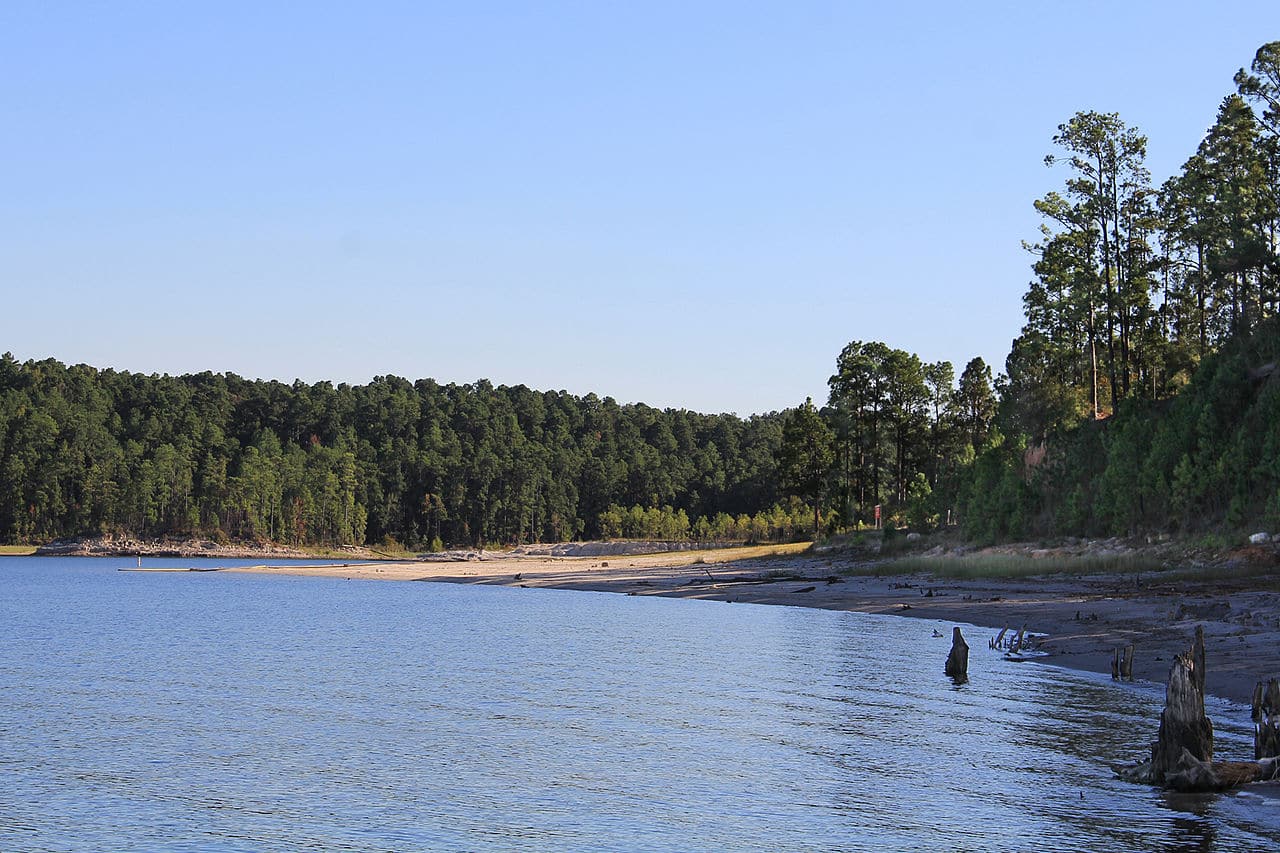
Located in Southeast Texas, Lake Sam Rayburn is a true gem for fishing aficionados. Stretching over an expansive 114,500 acres, it holds the title of the largest reservoir in the state. The lake’s vastness is only one part of its allure as the rich diversity of its fish populations truly sets it apart.
Lake Sam Rayburn is renowned for its impressive largemouth bass fishery, which draws in anglers nationwide. It is often the host of numerous fishing tournaments, further attesting to its reputation as a premium bass fishing location.
In addition to largemouth bass, the lake is abundant with crappie and catfish, offering anglers a varied fishing experience.
The lake features a mix of deep and shallow waters, inundated timber areas, and various structures, providing diverse habitats for its resident fish species.
Prime fishing spots include the Angelina River, Canyons, and creek channels, where water depth and structure provide ideal environments for various fish.
Angelina River, which feeds into the lake, is a prime location for largemouth bass, particularly during the spawning season.
The Canyons, a system of underwater valleys and ridges, is another popular spot for anglers targeting bass and catfish. The creek channels offer a variety of structures, depths, and are known for their crappie population.
| Lake Specifics | Sam Rayburn Reservoir Information |
|---|---|
| Location | Southeast Texas |
| GPS Coordinates | 31.0611° N, 94.1061° W |
| Area | 114,500 acres |
| Max Depth | 80 feet |
| Shoreline Length | 750 miles |
| Mean Depth | 20 feet |
| Elevation | 164 feet above sea level |
| Volume | 3,997,600 acre-feet |
| Fish Species | Largemouth Bass, Crappie, Catfish, others |
| Marinas | Jackson Hill Marina, Rayburn Marina, etc. |
2. Lake Fork
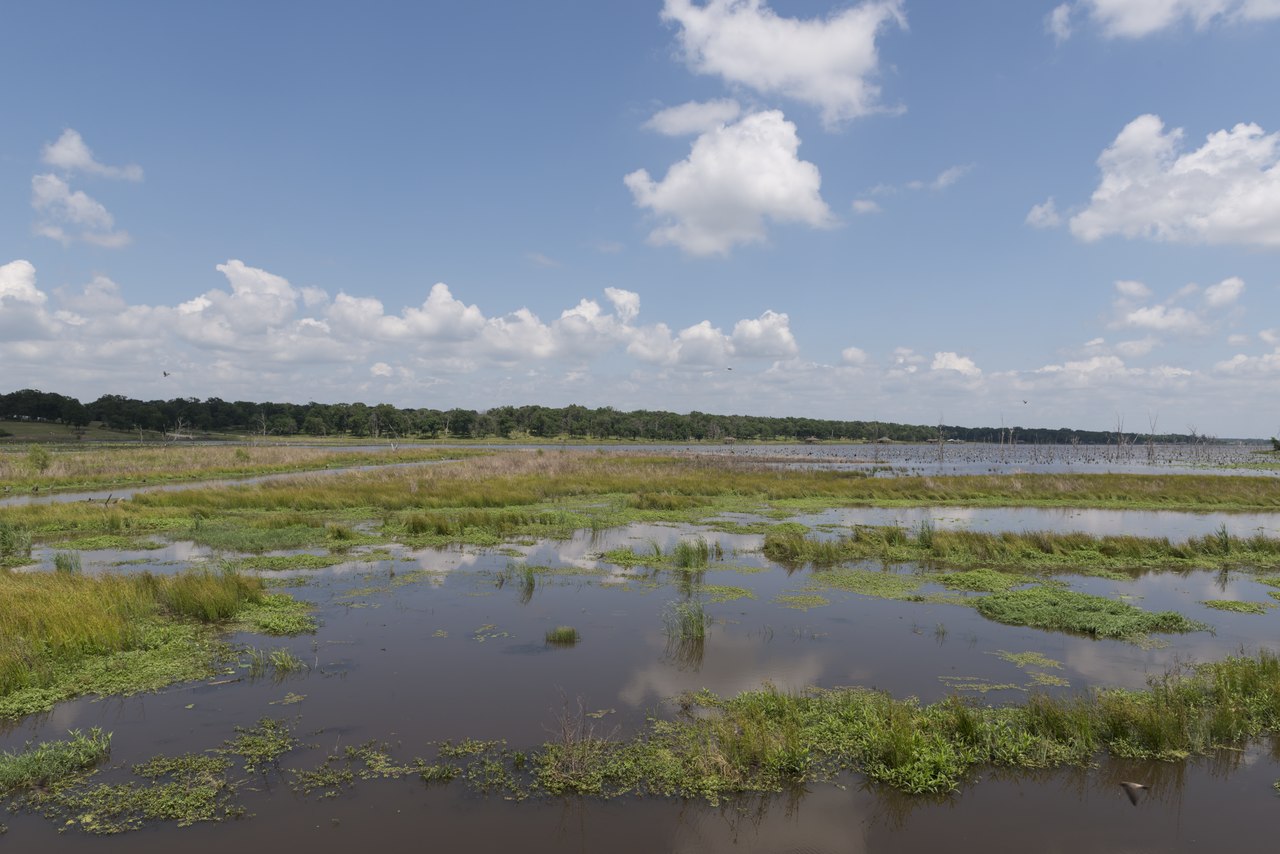
Lake Fork is widely recognized as the “Bass Capital of Texas” in Northeast Texas due to its well-earned reputation for largemouth bass fishing.
This 27,690-acre lake is a beacon for anglers nationwide, drawing them in with the promise of catching trophy-sized largemouth bass.
Lake Fork’s thriving ecosystem, supported by its rich vegetation and varied underwater structures, contributes significantly to its standing as an eminent bass fishery.
The lake’s various depths, vegetation-filled coves, and numerous creek channels create an ideal environment for growing and maintaining a healthy bass population.
Notable fishing spots include the dam area, Birch Creek, and the many channels and points. The dam area offers deep waters and submerged structures, ideal for attracting larger bass.
Birch Creek is another hotspot, particularly during the bass spawning season in spring. The numerous points and creek channels around the lake also offer diverse fishing opportunities.
Strict fishing regulations by the Texas Parks and Wildlife Department have been crucial in preserving Lake Fork’s world-renowned status as a top bass fishing destination.
The regulations, including a slot limit for bass, ensure the sustainability of the bass population and maintain the quality of the fishing experience.
| Lake Specifics | Information |
|---|---|
| Location | Northeast Texas |
| GPS Coordinates | 32.8311° N, 95.5830° W |
| Area | 27,690 acres |
| Max Depth | 70 feet |
| Shoreline Length | 315 miles |
| Mean Depth | 15 feet |
| Elevation | 403 feet above sea level |
| Volume | 675,819 acre-feet |
| Fish Species | Largemouth Bass |
| Marinas | Lake Fork Marina, Lake Fork Marina West, etc. |
3. Lake Texoma
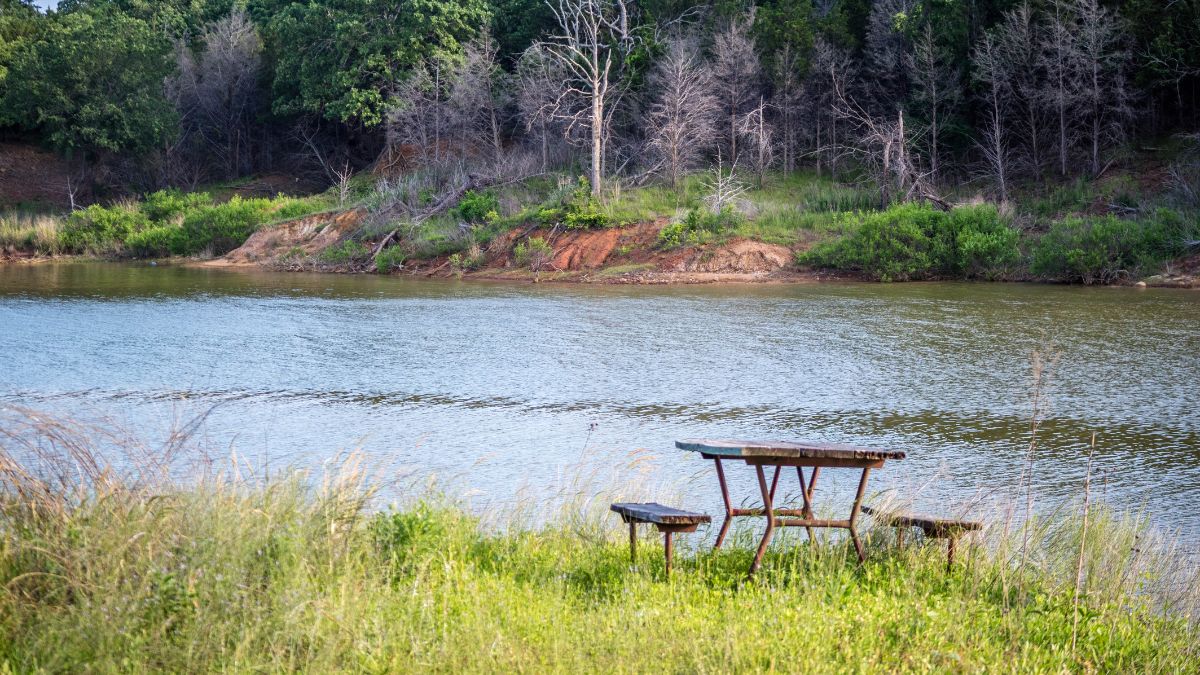
Straddling the Texas-Oklahoma border, Lake Texoma stands out as a distinctive fishing spot. This enormous 89,000-acre reservoir has made a name for itself with its unparalleled striped bass fishery, drawing in both novice and experienced anglers alike.
Lake Texoma is not just about striped bass, though. The lake offers other fish species, including catfish, crappie, and largemouth bass. The diverse fish population and the lake’s scenic beauty offer an unmatched angling experience.
The lake’s varied underwater terrain, featuring a blend of deep waters and shallows and numerous coves and islands, provides a perfect environment for different species to thrive.
Key fishing spots include the Eisenhower State Park, the Washita River arm, and the Red River arm.
The Eisenhower State Park area is known for its shore and pier fishing opportunities. With their creek channels and depth variations, the Washita and Red River arms are popular among anglers targeting striped bass and catfish.
| Lake Specifics | Information |
|---|---|
| Location | Texas-Oklahoma border |
| GPS Coordinates | 33.8628° N, 96.7561° W |
| Area | 89,000 acres |
| Max Depth | 100 feet |
| Shoreline Length | 580 miles |
| Mean Depth | 54 feet |
| Elevation | 615 feet above sea level |
| Volume | 4,200,000 acre-feet |
| Fish Species | Striped Bass, Catfish, Crappie, Largemouth Bass and Others |
| Marinas | Highport Marina, Alberta Creek Resort, etc. |
4. Lake Amistad
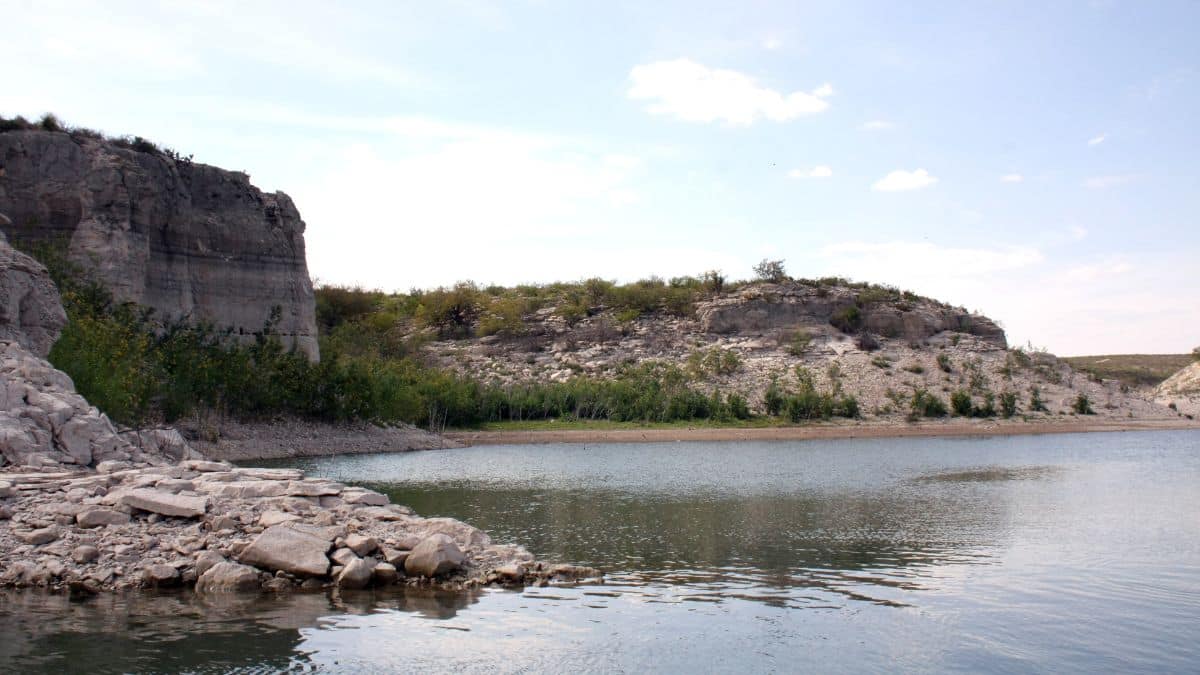
Located on the Texas-Mexico border, Lake Amistad is an angler’s delight, characterized by its pristine waters and breathtaking landscapes.
Lake Amistad is known for its robust bass fishery, offering opportunities to catch trophy-sized largemouth and smallmouth bass.
The clear water and the lake’s varied underwater structures provide excellent habitats for these species. The lake is also home to a healthy catfish population, adding to the diversity of the angling experience.
The lake’s notable fishing spots include the Devils River arm, the Rio Grande River arm, and various coves around the lake. The Devil’s River arm, with its clear waters and rocky structures, is a favored spot for bass.
The Rio Grande River arm provides diverse fishing opportunities due to the variation in depth and structure. The coves around the lake are known for their quiet waters, making them ideal spots for targeting catfish.
| Lake Specifics | Information |
|---|---|
| Location | Texas-Mexico border |
| GPS Coordinates | 29.4689° N, 101.0881° W |
| Area | 64,900 acres |
| Max Depth | 217 feet |
| Shoreline Length | 850 miles |
| Mean Depth | 65 feet |
| Elevation | 1,117 feet above sea level |
| Volume | 4,175,000 acre-feet |
| Fish Species | Largemouth Bass, Smallmouth Bass, Catfish |
| Marinas | Diablo East Marina, Box Canyon Marina, etc. |
5. Falcon International Reservoir
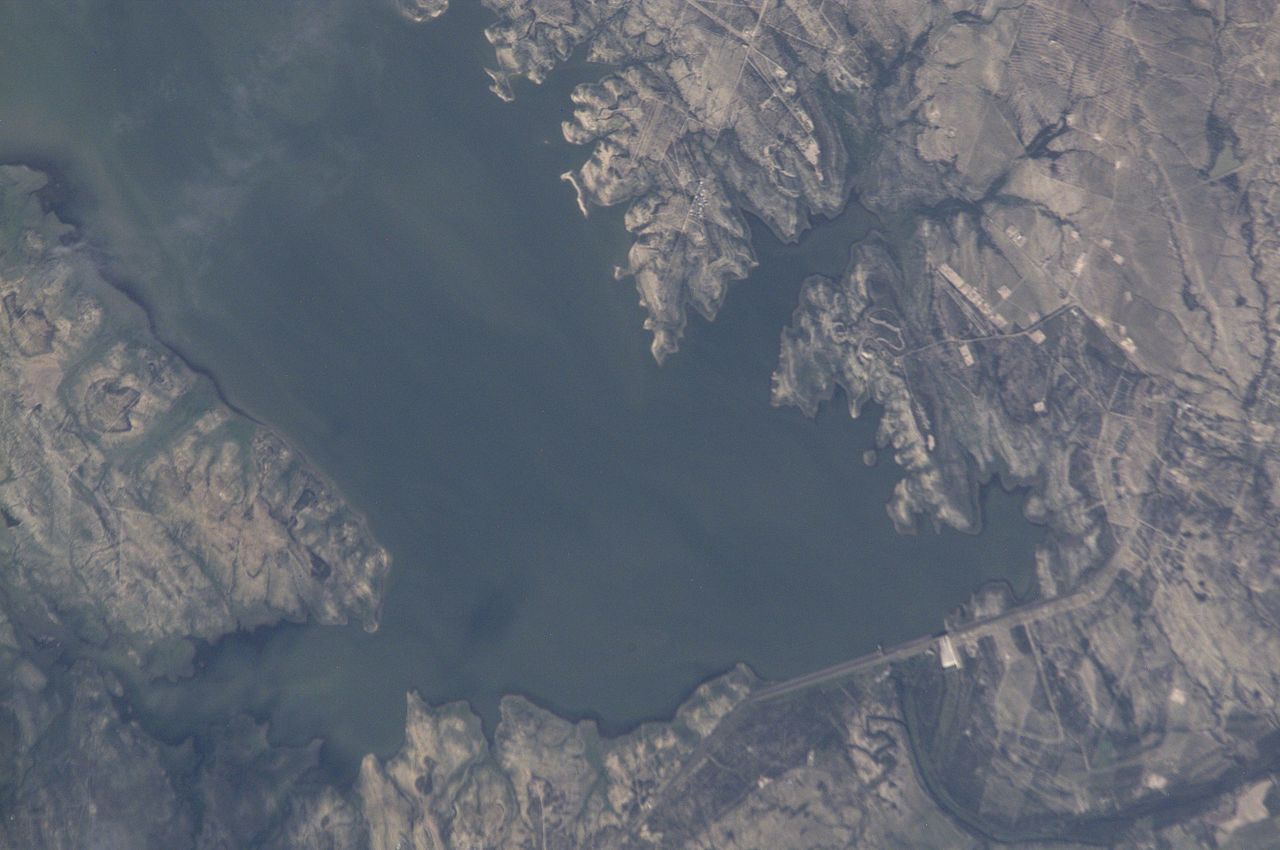
Falcon International Reservoir, or Falcon Lake, is situated along the Rio Grande, serving as a natural border between Texas and Mexico. This lake is legendary among the fishing community, particularly for its world-class largemouth bass fishing opportunities.
Spanning a substantial 83,654 acres, Falcon Lake is teeming with largemouth bass, drawing anglers from all corners of the globe.
The lake’s prosperous aquatic ecosystem, characterized by dense underwater vegetation and varied structures, provides an ideal habitat for bass. Anglers can often explore the lake’s depths in pursuit of a trophy catch.
Falcon Lake supports a variety of other fish species, such as catfish and crappie, further enriching the angling experience. The vast shoreline of Falcon Lake, adorned with numerous creeks and coves, offers countless fishing spots.
Key fishing areas include the Veleno Grande River, the Salado River, and the various coves along the shore.
The Veleno Grande River and Salado River arms are known for their productive bass fishing, particularly during the spawning season. The coves along the shore provide quiet waters, making them ideal spots for targeting other species, such as catfish.
The rich fishing opportunities combined with the stunning landscapes of Falcon Lake make it an exceptional destination for any angler looking for an unforgettable fishing adventure.
| Lake Specifics | Falcon International Reservoir Information |
|---|---|
| Location | Rio Grande, Texas-Mexico border |
| GPS Coordinates | 26.7886° N, 99.2453° W |
| Area | 83,654 acres |
| Max Depth | 110 feet |
| Shoreline Length | 265 miles |
| Mean Depth | 40 feet |
| Elevation | 295 feet above sea level |
| Volume | 3,339,000 acre-feet |
| Fish Species | Largemouth Bass |
| Marinas | Falcon Lake Tackle & RV Park, Zapata County Boat Ramp, etc. |
6. Lake Conroe
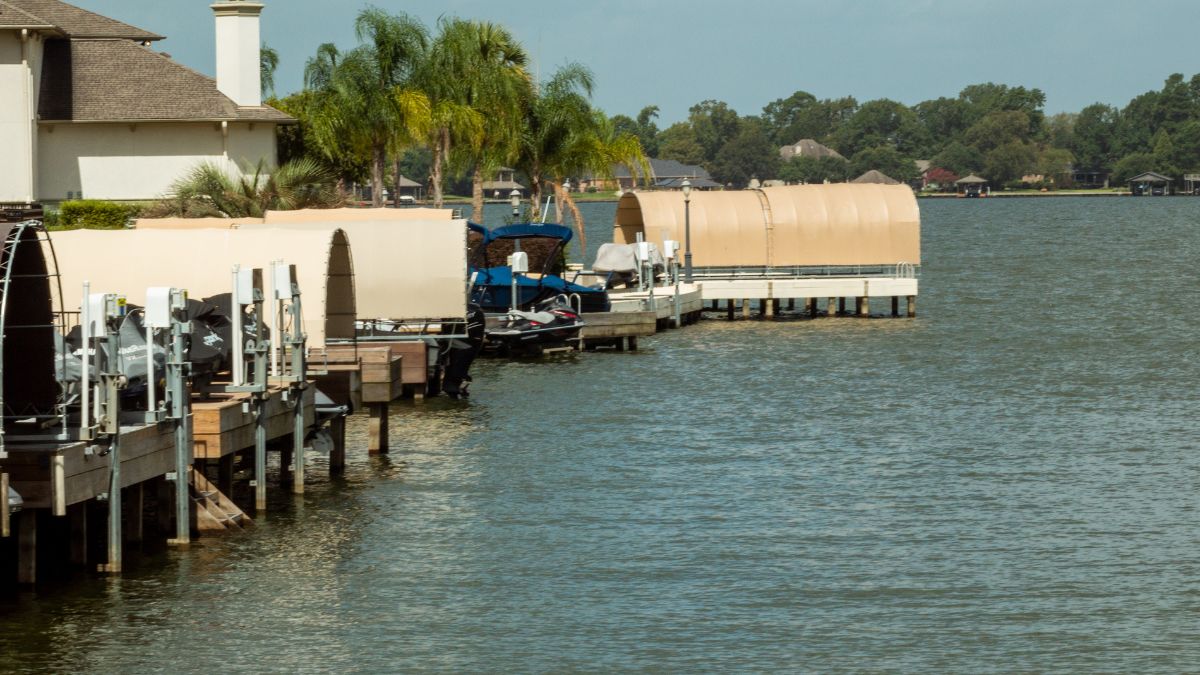
Lake Conroe is a convenient fishing haven for anglers just a stone’s throw from Houston. Covering 21,000 acres, this scenic lake offers abundant bank fishing and boating opportunities.
Anglers at Lake Conroe can cast their lines for various species, including largemouth bass, catfish, and crappie.
Lake Conroe’s diverse underwater landscape, marked by its many points, creek channels, and underwater structures, creates an ideal environment for these fish species. The lake’s water clarity and depth variation further enhance the habitat, contributing to a healthy and diverse fish population.
The popular fishing spots around the lake include the dam area, the upper lake, and the various coves and points. The dam area, known for its deeper waters and submerged structures, is favored for bass fishing.
With its shallower waters and dense vegetation, the upper lake offers excellent opportunities for targeting catfish and crappie. The coves and points around the lake provide a mix of habitats suitable for various species.
| Lake Specifics | Information |
|---|---|
| Location | Near Houston, Texas |
| GPS Coordinates | 30.4369° N, 95.5985° W |
| Area | 21,000 acres |
| Max Depth | 75 feet |
| Shoreline Length | 157 miles |
| Mean Depth | 20 feet |
| Elevation | 201 feet above sea level |
| Volume | 420,000 acre-feet |
| Fish Species | Largemouth Bass, Catfish, Crappie, others |
| Marinas | April Plaza Marina, Stow-A-Way Marina, etc. |
7. Lake Whitney
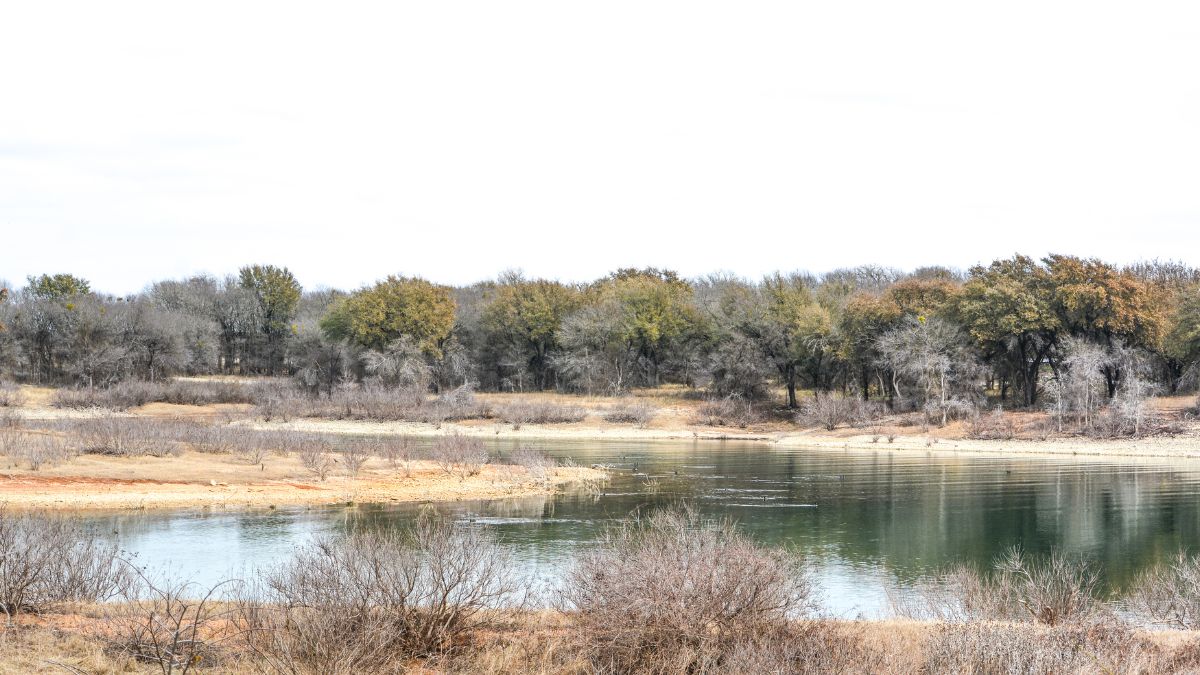
Situated near Waco, Lake Whitney is a beautiful reservoir offering superb fishing opportunities. Covering an expansive area of 23,560 acres, the lake provides a vast water body for anglers to venture into its rich aquatic life.
Lake Whitney holds a notable reputation for its striped bass fishing. The lake’s varied underwater terrain, complemented by its clear waters, provides an ideal habitat for this species.
In addition, anglers can also reel in largemouth bass, catfish, and other sought-after species, adding to the diverse fishing experience.
Key fishing spots at Lake Whitney include the dam area, Cedar Creek, and numerous coves along the shoreline.
With its deep waters and submerged structures, the dam area attracts large striped bass. Cedar Creek, known for its meandering waterway and depth variations, is a hotspot for largemouth bass and catfish. The coves along the shoreline offer calm waters, perfect for a peaceful day of fishing.
| Lake Specifics | Information |
|---|---|
| Location | Near Waco, Texas |
| GPS Coordinates | 41.3604° N, 72.9173° W |
| Area | 23,560 acres |
| Max Depth | 108 feet |
| Shoreline Length | 225 miles |
| Mean Depth | 35 feet |
| Elevation | 522 feet above sea level |
| Volume | 673,000 acre-feet |
| Fish Species | Striped Bass, Largemouth Bass, Catfish, Smallmouth Bass |
| Marinas | McCown Valley Park Marina, Juniper Cove Marina, etc. |
8. Lake Livingston
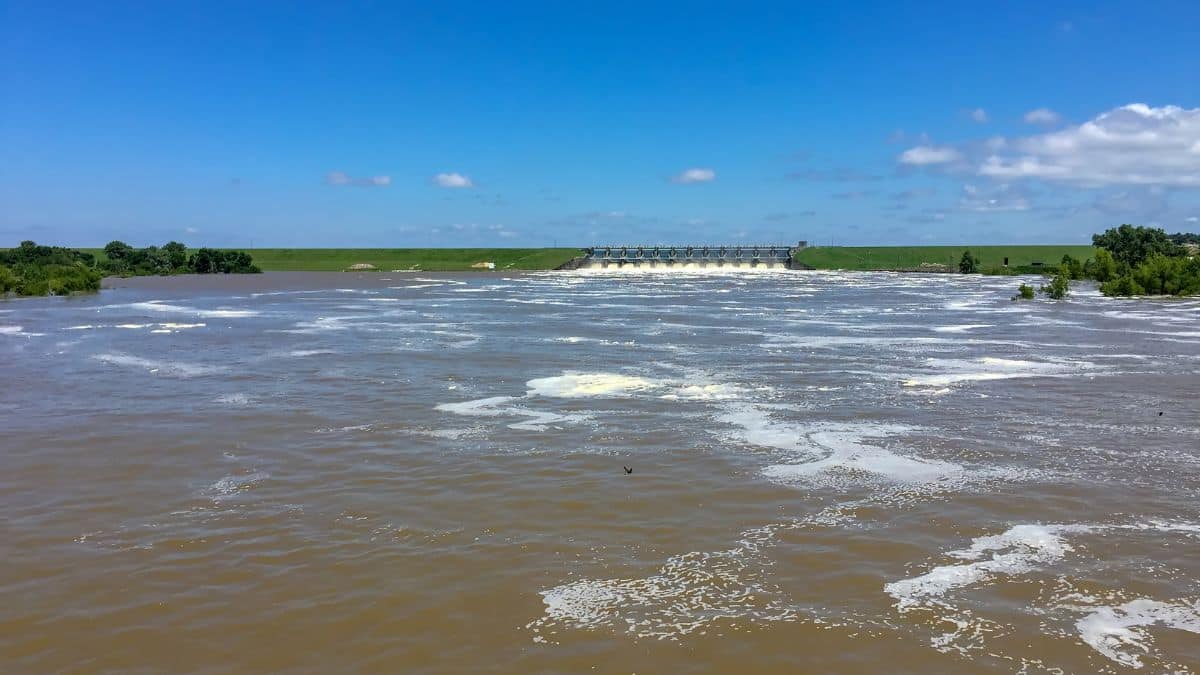
With its significant area of 93,000 acres, Lake Livingston stands as one of Texas’s largest lakes. This lake in East Texas delivers excellent fishing opportunities throughout the year.
Lake Livingston is home to various fish species, allowing anglers to target catfish, white bass, crappie, and largemouth bass. The lake’s diverse underwater environment, marked by its variety of depths, structures, and vegetation, serves as a perfect habitat for these species.
Noteworthy fishing spots around Lake Livingston include Kickapoo Creek, White Rock Creek, and the many points along the 450-mile shoreline. Kickapoo Creek, known for its deeper waters and ample structure, is a hotspot for catfish and largemouth bass.
With its diverse habitat and depth changes, White Rock Creek is another favored spot for anglers targeting white bass and crappie. The points along the shoreline offer varied fishing opportunities, making them suitable for all skill levels.
| Lake Specifics | Information |
|---|---|
| Location | East Texas |
| GPS Coordinates | 30.7593° N, 95.1536° W |
| Area | 93,000 acres |
| Max Depth | 77 feet |
| Shoreline Length | 450 miles |
| Mean Depth | 23 feet |
| Elevation | 131 feet above sea level |
| Volume | 1,036,000 acre-feet |
| Fish Species | Catfish, White Bass, Crappie, Largemouth Bass, and Others |
| Marinas | Pine Island Marina, Lake Livingston Marina, etc. |
9. Lake Buchanan
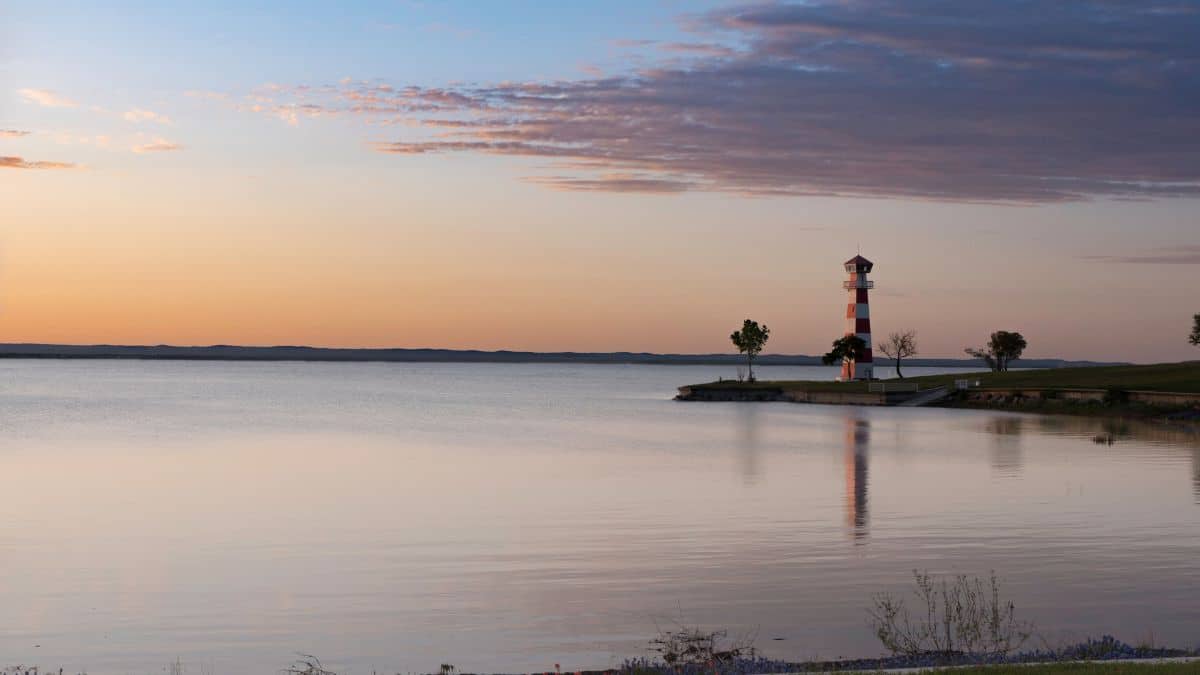
Lake Buchanan presents a tranquil fishing getaway for anglers in the scenic Texas Hill Country. Occupying a generous 23,060 acres, the lake is recognized for its bountiful white bass and striped bass populations.
Lake Buchanan’s diverse underwater ecosystem, featuring a mixture of depth variations and structures, creates a conducive environment for these fish species. Anglers can reel in catfish and other popular species, further diversifying the fishing experience.
Prime fishing spots at Lake Buchanan include the Colorado River arm, the various points, and the many coves around the lake.
The Colorado River arm, with its deeper waters and changing terrain, is a preferred spot for white and striped bass fishing. The points around the lake offer varied fishing opportunities, while the quiet coves provide excellent spots for targeting catfish.
| Lake Specifics | Information |
|---|---|
| Location | Texas Hill Country |
| GPS Coordinates | 30.7935° N, 98.4294° W |
| Area | 23,060 acres |
| Max Depth | 132 feet |
| Shoreline Length | 124 miles |
| Mean Depth | 30 feet |
| Elevation | 1,020 feet above sea level |
| Volume | 695,400 acre-feet |
| Fish Species | White Bass, Striped Bass, Catfish, others |
| Marinas | Llano County Park Marina, Big Chief RV & Cabin Resort, etc. |
10. Lake Travis
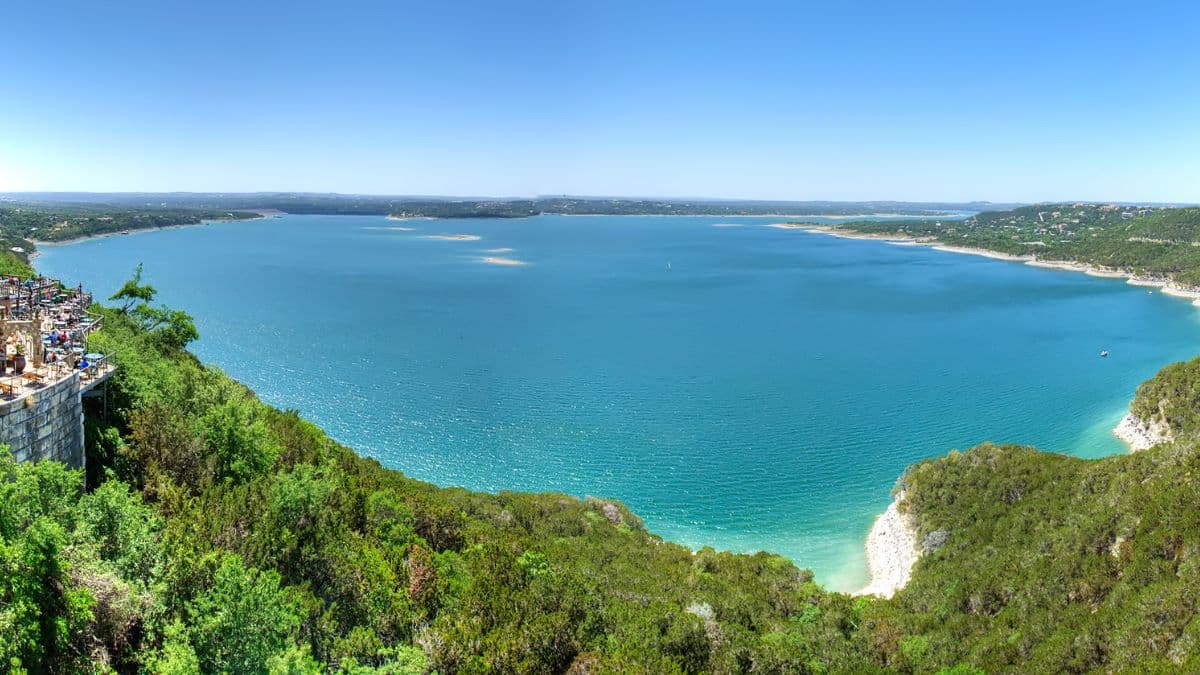
Nestled near Austin in the beautiful Texas Hill Country, Lake Travis offers anglers a remarkable fishing experience in a picturesque setting. Spanning an area of 18,930 acres, this lake provides ample space and diverse fishing opportunities for anglers to pursue their favorite species.
Lake Travis is renowned for its excellent largemouth bass fishery, attracting anglers with the promise of thrilling catches. In addition to largemouth bass, the lake is home to catfish, including channel catfish and blue catfish, as well as sunfish species, such as bluegill and redear sunfish.
The scenic beauty of the Texas Hill Country serves as a stunning backdrop to the angling experience at Lake Travis. The lake’s expansive waters, surrounded by rolling hills and lush vegetation, create an atmosphere of tranquility and natural splendor.
Key fishing spots at Lake Travis include the main basin, the many coves, and the submerged structures and drop-offs.
The main basin provides opportunities for targeting a variety of species, while the coves offer sheltered areas for fishing. Anglers can explore the lake’s underwater structures and drop-offs, favored by bass and catfish.
| Lake Specifics | Information |
|---|---|
| Location | Near Austin, Texas |
| GPS Coordinates | 30.4205° N, 97.9103° W |
| Area | 18,930 acres |
| Max Depth | 210 feet |
| Shoreline Length | 270 miles |
| Mean Depth | 62 feet |
| Elevation | 681 feet above sea level |
| Volume | 1,025,000 acre-feet |
| Fish Species | Largemouth Bass, Catfish, Sunfish |
| Marinas | Mansfield Dam Park, Lakeway Marina, etc. |
11. Lake Ray Roberts
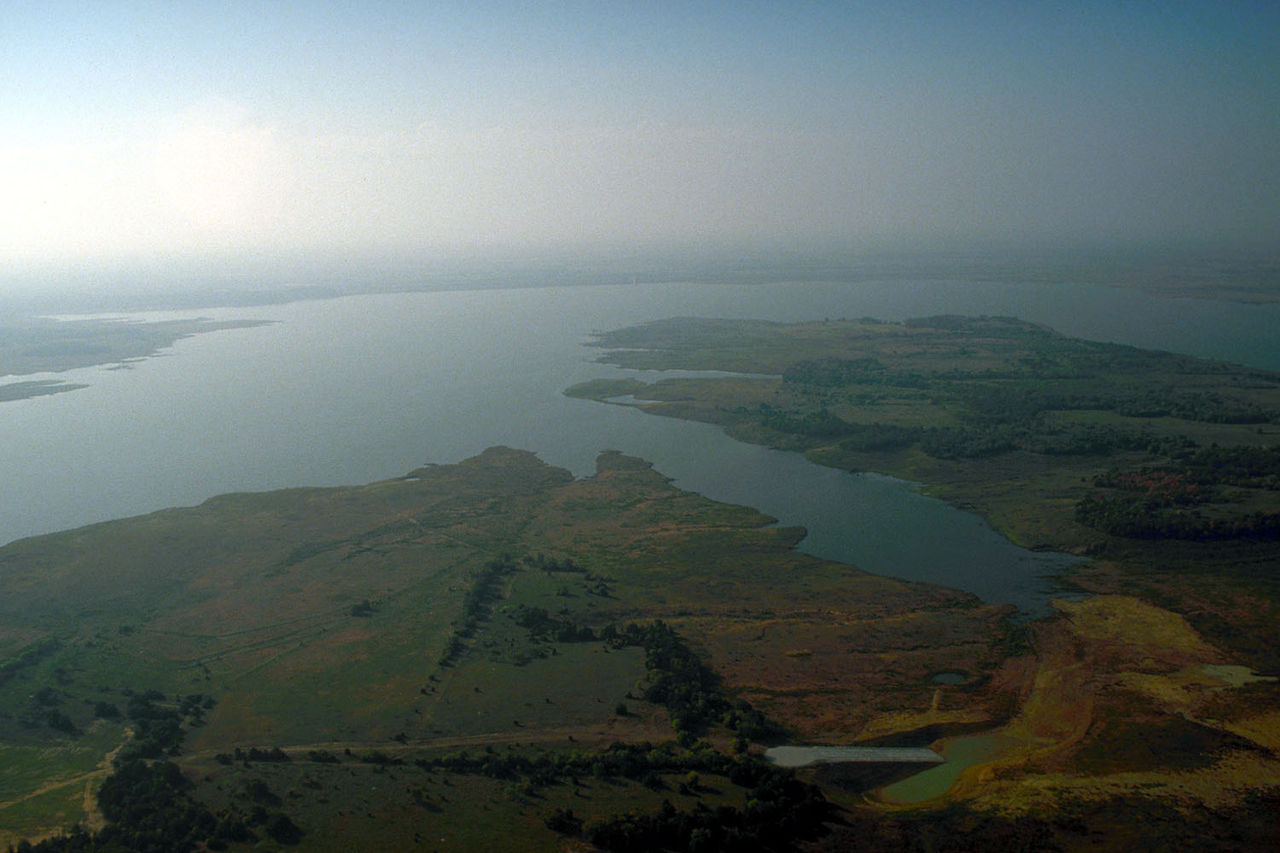
Located just north of Denton, Lake Ray Roberts is a haven for anglers, offering fantastic fishing opportunities and stunning landscapes. As the newest lake on our list, Lake Ray Roberts has swiftly gained popularity among fishing enthusiasts.
Encompassing a vast area of 29,350 acres, this reservoir provides ample space for anglers to explore its abundant waters.
Lake Ray Roberts is home to a diverse range of fish species, including largemouth bass, crappie, and catfish, ensuring a varied and exciting fishing experience for anglers of all preferences.
The picturesque landscapes surrounding Lake Ray Roberts enhance the fishing ambiance, allowing anglers to immerse themselves in the area’s natural beauty. The tranquil atmosphere and pristine waters of the lake create an idyllic setting for casting lines and enjoying the serenity of the outdoors.
Anglers can explore various fishing spots around the lake, including submerged structures, creek channels, and points. These areas offer ideal habitats for different fish species and allow anglers to test their skills and techniques.
| Lake Specifics | Information |
|---|---|
| Location | North of Denton |
| GPS Coordinates | 33.4245° N, 97.0230° W |
| Area | 29,350 acres |
| Max Depth | 106 feet |
| Shoreline Length | 110 miles |
| Mean Depth | 22 feet |
| Elevation | 633 feet above sea level |
| Volume | 645,200 acre-feet |
| Fish Species | Largemouth Bass, Crappie, Catfish, others |
| Marinas | Ray Roberts Marina, Jordan Park Marina, etc. |
12. Lake O’ the Pines
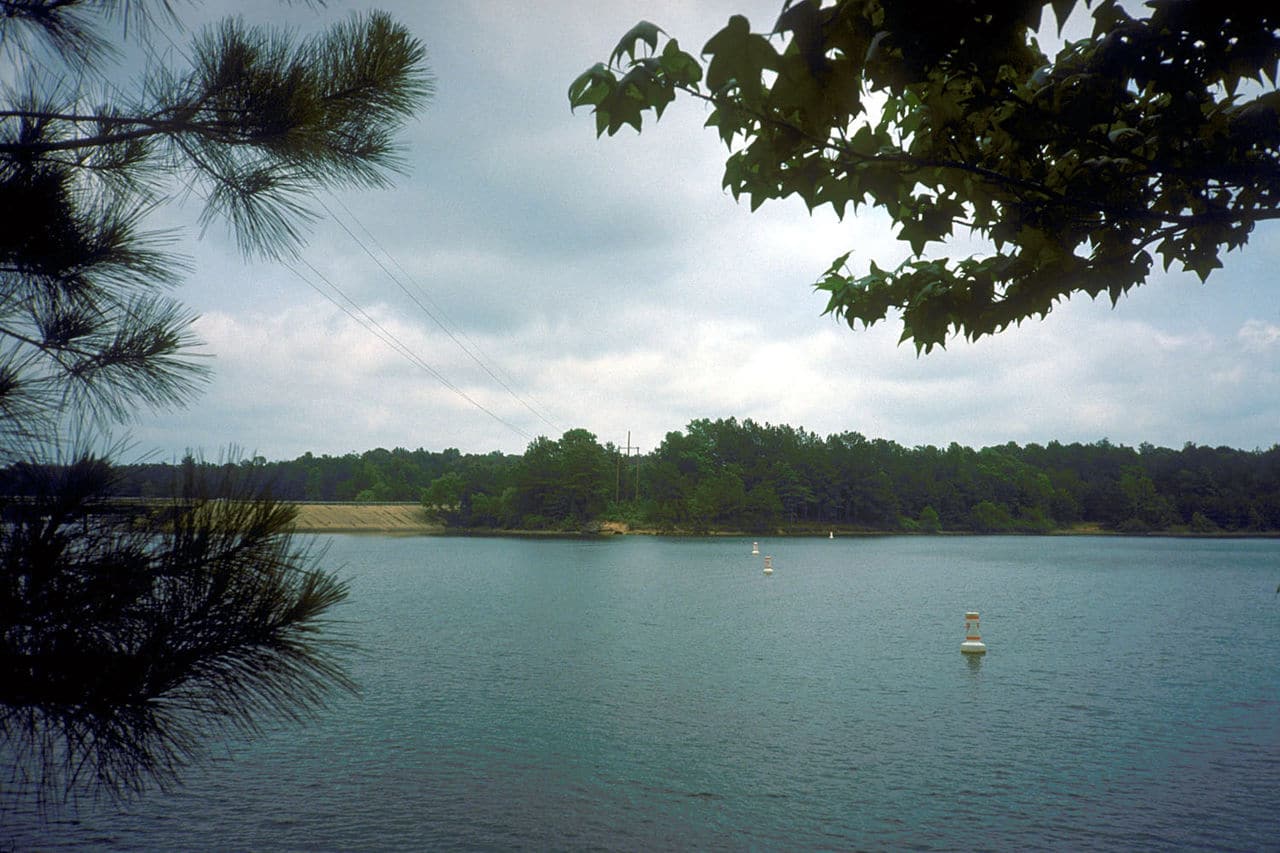
Lake O’ the Pines offers anglers a tranquil fishing experience in the breathtaking East Texas Piney Woods. Spanning an area of 18,700 acres, this picturesque lake offers a peaceful retreat amidst nature’s beauty.
Lake O’ the Pines is home to many fish species, providing anglers with diverse targets. Largemouth bass, known for their thrilling fights, are popular in these calm waters. Additionally, anglers can pursue catfish, crappie, and sunfish, further adding to the angling opportunities available.
Lake O’ the Pines’ calm and serene atmosphere creates the perfect environment for a peaceful fishing experience. The scenic surroundings of the East Texas Piney Woods serve as a beautiful backdrop, allowing anglers to connect with nature while casting their lines.
Anglers can explore fishing spots around the lake, including submerged structures, creek channels, and vegetation-rich areas.
| Lake Specifics | Information |
|---|---|
| Location | East Texas |
| GPS Coordinates | 32.7968° N, 94.6192° W |
| Area | 18,700 acres |
| Max Depth | 49 feet |
| Shoreline Length | 160 miles |
| Mean Depth | 15 feet |
| Elevation | 245 feet above sea level |
| Volume | 280,000 acre-feet |
| Fish Species | Largemouth Bass, Catfish, Crappie, Sunfish |
| Marinas | Johnson Creek Marina, Alley Creek Camp, etc. |
13. Lake Granbury
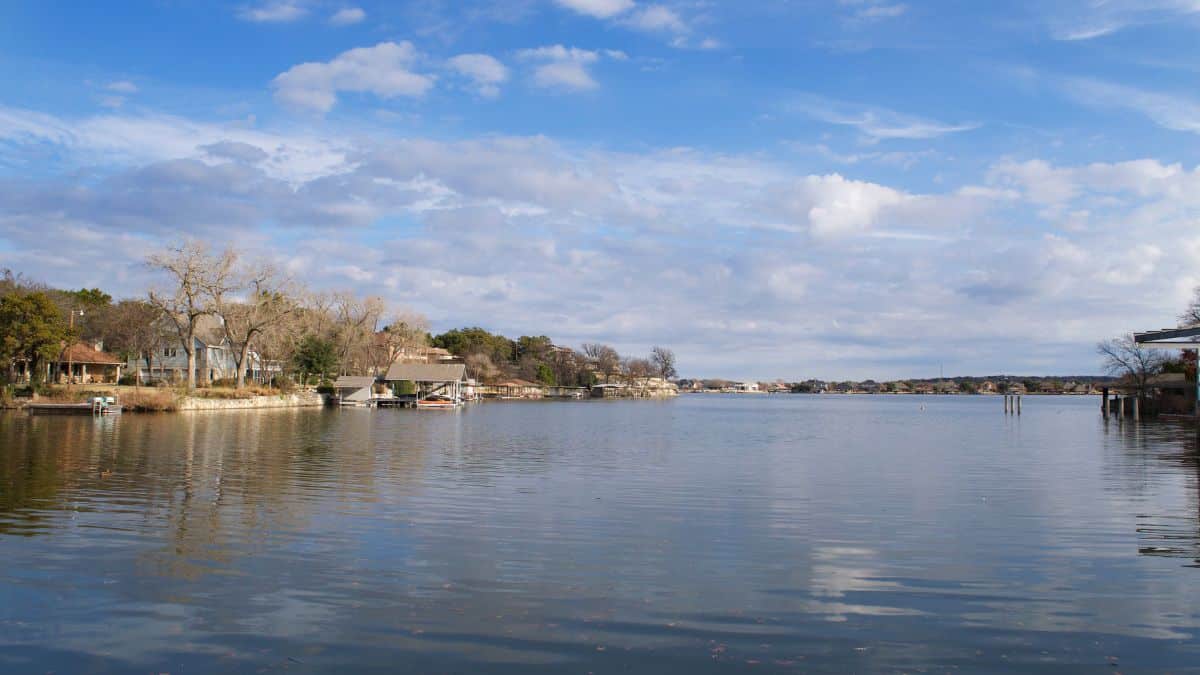
Lake Granbury, located near the town of Granbury in Texas, is a prime destination for fishing enthusiasts seeking excellent fishing opportunities and a charming small-town atmosphere.
Spanning an area of 8,310 acres, this picturesque lake offers ample space for anglers to explore and indulge in their fishing adventures.
One of the standout features of Lake Granbury is its reputation for trophy-sized largemouth bass and white bass populations.
Anglers are drawn to the lake in pursuit of these prized catches, providing an exciting challenge and the chance to reel in impressive specimens. Catfish and crappie are also abundant in the lake, adding to the variety of fishing experiences available.
As anglers cast their lines, they can immerse themselves in the scenic beauty that surrounds Lake Granbury. The tranquil waters and natural landscapes create a serene ambiance, enhancing the overall fishing experience.
The small-town atmosphere of Granbury itself adds to the charm, providing a welcoming and relaxed environment for visitors.
Anglers can explore various fishing spots throughout Lake Granbury, including areas with submerged structures, creek channels, and points. These locations offer ideal habitats for different fish species and provide opportunities to employ various fishing techniques.
| Lake Specifics | Information |
|---|---|
| Location | Near Granbury, Texas |
| GPS Coordinates | 32.4899° N, 97.8096° W |
| Area | 8,310 acres |
| Max Depth | 75 feet |
| Shoreline Length | 103 miles |
| Mean Depth | 26 feet |
| Elevation | 690 feet above sea level |
| Volume | 155,000 acre-feet |
| Fish Species | Largemouth Bass, White Bass, Catfish, Crappie |
| Marinas | City of Granbury Boat Docks, De Cordova Bend Marina, etc. |
14. Toledo Bend Reservoir

Toledo Bend Reservoir is a large and diverse body of water providing excellent fishing opportunities. The best spots for fishing usually depend on the time of year, water temperature, and the specific species of fish you’re targeting.
Some popular fishing spots at Toledo Bend Reservoir include the Six Mile Creek, Housen Bay, and the Indian Mounds area. Each of these locations offer a different kind of environment with varying depths and structures, suitable for different types of fishing.
The Six Mile Creek is known for its deep waters, which can be a good location to fish for striped bass. Housen Bay is a shallow bay area good for white bass and blue catfish.
Indian Mounds is popular for its underwater structure, making it a great spot for all species, particularly in the warmer months when fish are looking for places to hide and stay cool.
| Lake Specifics | Information |
|---|---|
| Location | On the Sabine River between Texas and Louisiana |
| GPS Coordinates | 31.5947° N, 93.8045° W |
| Area | 185,000 acres (surface area) |
| Max Depth | 110 feet |
| Shoreline Length | 1,264 miles |
| Mean Depth | 20.6 feet |
| Elevation | 172 feet above sea level (at conservation pool level) |
| Volume | 4.477 million acre-feet |
| Fish Species | Largemouth bass, white & striped bass, crappie, catfish, sunfish, etc. |
| Marinas | Pendleton Harbor Marina, Holly Park Marina, Cypress Bend Marina, etc. |
15. Caddo Lake
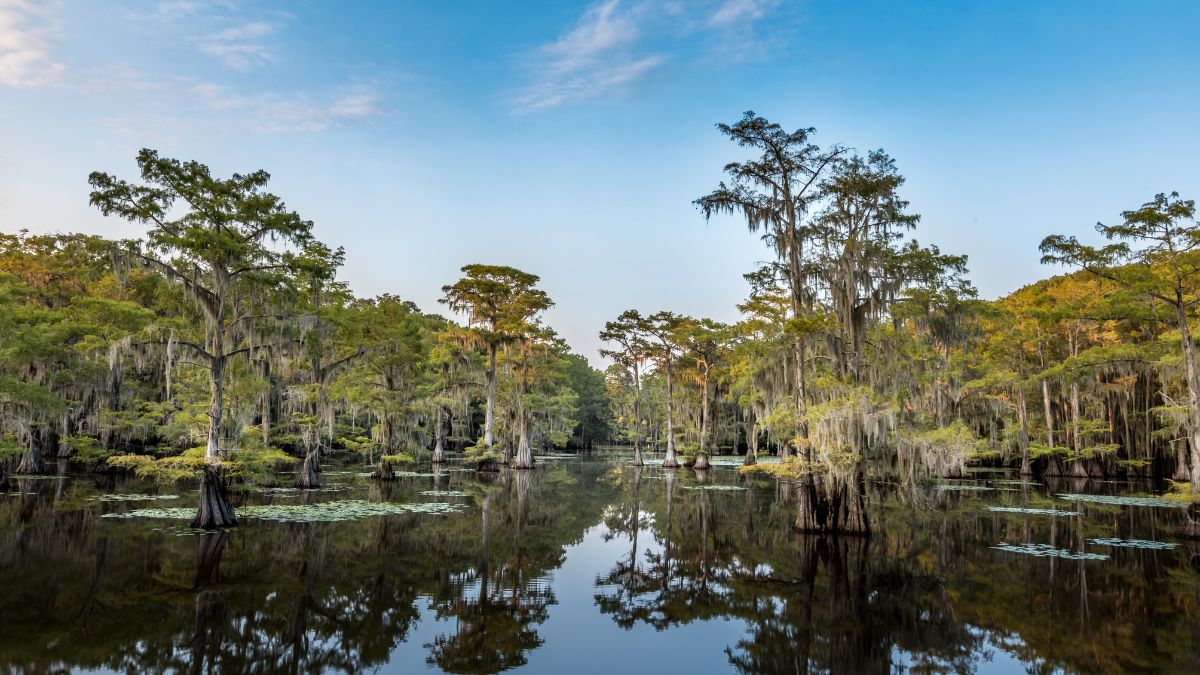
Caddo Lake, located in Texas and extending into Louisiana, is known for its biodiversity and its unique, haunting beauty. It’s a wonderful spot for anglers who enjoy fishing in a scenic, peaceful setting.
Fishing hotspots on Caddo Lake include Big Cypress Bayou, Haggerty Creek, and Black Bayou. These areas are popular due to their unique vegetation, including cypress trees and lily pads, which provide ideal environments for fish.
Big Cypress Bayou is known for its dense aquatic vegetation, providing excellent cover for largemouth bass.
Haggerty Creek is an excellent location for channel catfish, especially near the mouth of the creek. Black Bayou offers productive fishing for largemouth bass and catfish with its unique mix of shallow and deep water.
| Lake Specifics | Information |
|---|---|
| Location | Straddles the Texas-Louisiana border |
| GPS Coordinates | 32.7104° N, 94.0185° W |
| Area | 25,400 acres (surface area) |
| Max Depth | 20 feet |
| Shoreline Length | 200 miles |
| Mean Depth | 8-10 feet |
| Elevation | 168.5 feet above sea level |
| Volume | 204,000 acre-feet |
| Fish Species | Largemouth bass, crappie, white bass, channel catfish, bluegill, etc. |
| Marinas | Shady Glade Marina, Johnson’s Ranch Marina, Caddo Lake Bayou Tours, etc. |
16. OH Ivie Lake
O.H. Ivie Lake, located in West Texas, is a renowned fishing location due to its diverse range of fish species and deep waters. The lake is especially known for its largemouth bass fishing but also holds substantial populations of flathead and blue catfish.
The Concho Park Marina, Elm Creek, and the Mustang Branch are well-known fishing spots within the lake. Concho Park Marina is particularly popular due to its facilities and accessibility, while Elm Creek and Mustang Branch provide excellent fishing environments with varying depths and structures.
| Lake Specifics | Information |
|---|---|
| Location | West Texas |
| GPS Coordinates | 31.5397° N, 99.6843° W |
| Area | 19,149 acres (surface area) |
| Max Depth | 119 feet |
| Shoreline Length | 163 miles |
| Mean Depth | 23.4 feet |
| Elevation | 1,551.5 feet above sea level |
| Volume | 554,340 acre-feet |
| Fish Species | Largemouth bass, white bass, crappie, catfish, sunfish, etc. |
| Marinas | Concho Park Marina, etc. |
17. Choke Canyon Reservoir
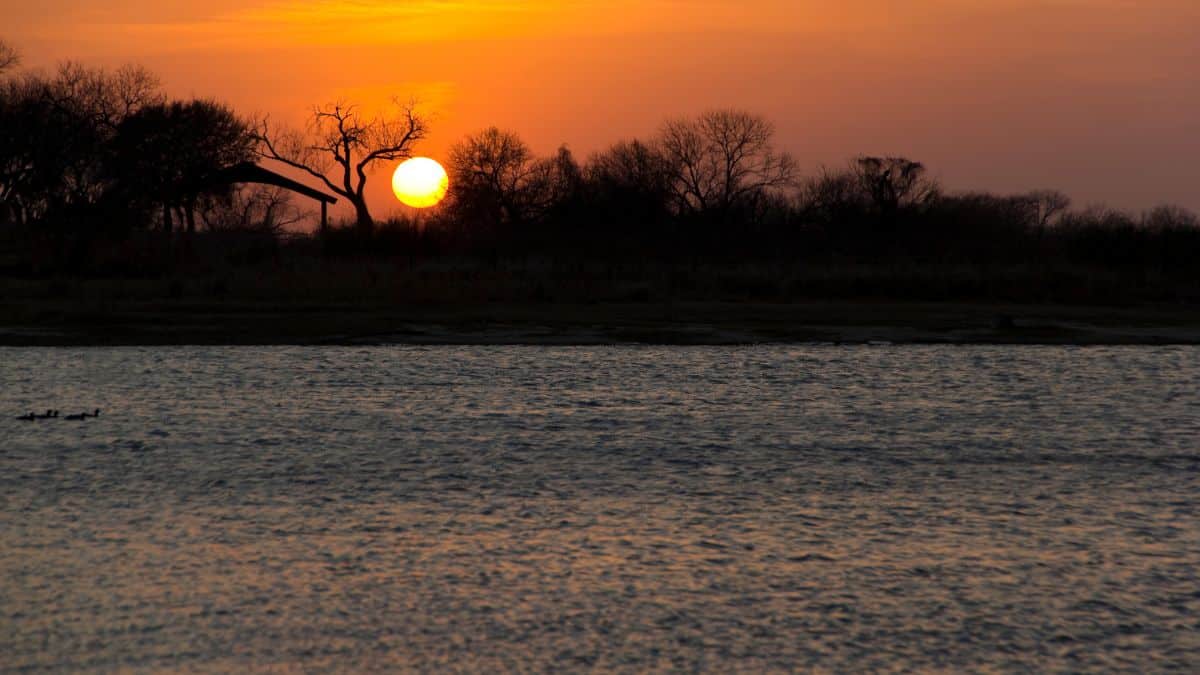
Choke Canyon Reservoir, located in South Texas, is a top-rated fishing destination known for its healthy populations of largemouth bass, crappie, and catfish. With its diverse ecosystem, this lake offers great opportunities for all kinds of anglers.
Popular fishing spots in Choke Canyon Reservoir include the South Shore Unit, Calliham’s Point, and the Mason Point area.
South Shore Unit provides access to shallower waters suitable for crappie and catfish. Calliham’s Point and Mason Point offer a variety of depths and structures for targeting largemouth bass.
| Lake Specifics | Information |
|---|---|
| Location | South Texas |
| GPS Coordinates | 28.4767° N, 98.3198° W |
| Area | 25,670 acres (surface area) |
| Max Depth | 95.5 feet |
| Shoreline Length | 130 miles |
| Mean Depth | 20.6 feet |
| Elevation | 220.5 feet above sea level |
| Volume | 691,130 acre-feet |
| Fish Species | Largemouth bass, crappie, catfish, sunfish, white bass, etc. |
| Marinas | Calliham Store, Choke Canyon State Park (North & South Shore), etc. |
18. Lake Alan Henry
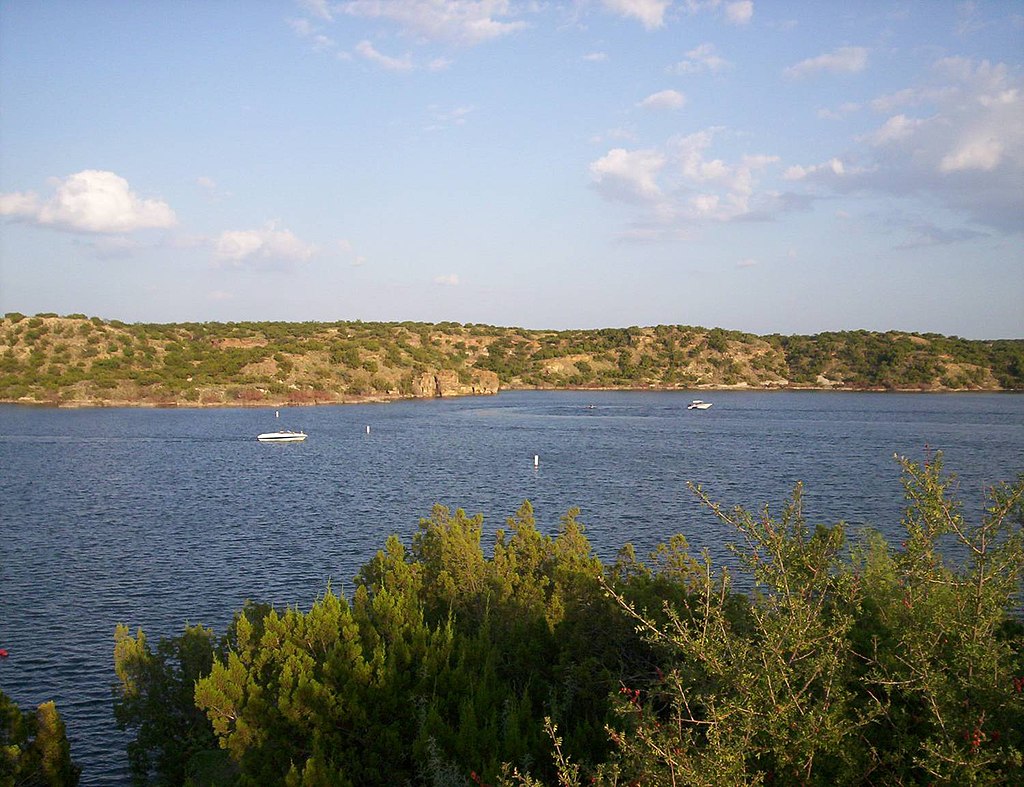
Lake Alan Henry Reservoir, located in West Texas, is popular among anglers for its exceptional largemouth bass fishing.
This lake also offers a healthy population of spotted bass and crappie. Its clear water and steep rocky shoreline make it a unique Texas fishing location.
Prime fishing spots at Lake Alan Henry Reservoir include the Wildcat Branch, Gobbler Creek, and the Rocky Creek area.
Wildcat Branch is known for its deep waters, ideal for spotted and largemouth bass. Gobbler Creek and Rocky Creek are notable for their varied structures and depths, providing great crappie and bass fishing opportunities.
| Lake Specifics | Information |
|---|---|
| Location | West Texas |
| GPS Coordinates | 33.0595° N, 101.0528° W |
| Area | 2,880 acres (surface area) |
| Max Depth | 100 feet |
| Shoreline Length | 56 miles |
| Mean Depth | 40 feet |
| Elevation | 2,220 feet above sea level |
| Volume | 167,600 acre-feet |
| Fish Species | Largemouth bass, spotted bass, crappie, catfish, etc. |
| Marinas | Sam Wahl Recreation Area, etc. |
19. Lake Palestine
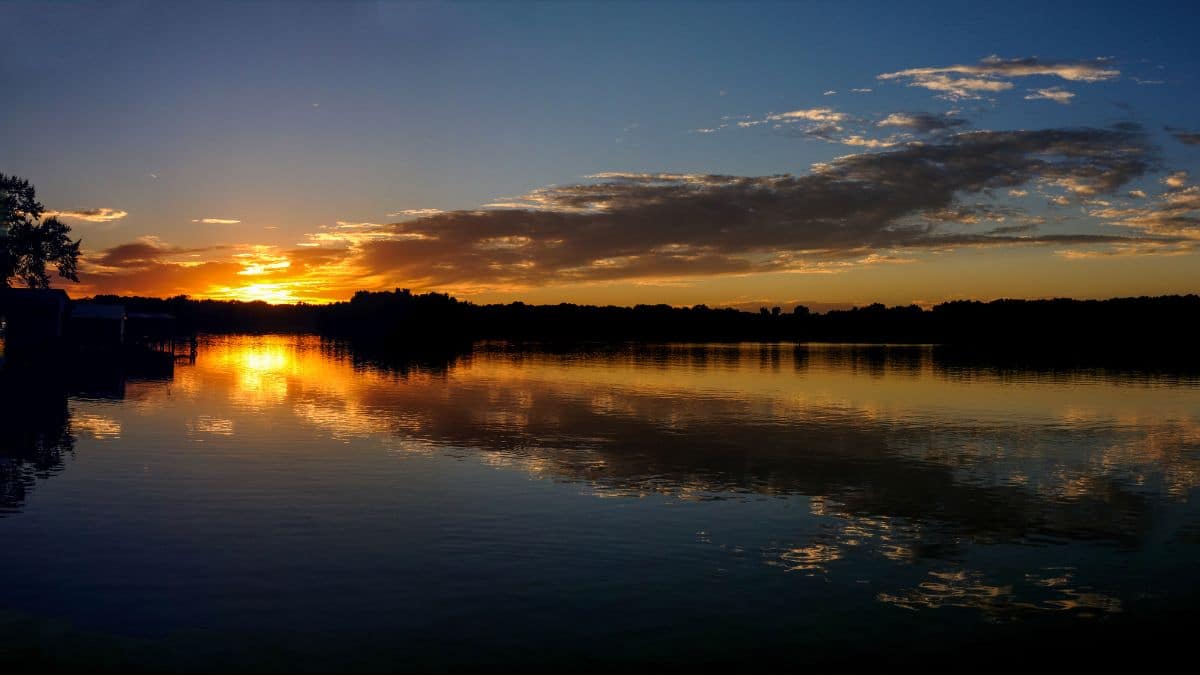
Lake Palestine, located in East Texas, is a popular fishing location renowned for its largemouth bass, crappie, and catfish populations. The lake’s diversity of water depths and structures provides various fishing opportunities.
Some notable fishing spots at Lake Palestine include Kickapoo Creek, Flat Creek, and Ledbetter Bay.
Kickapoo Creek and Flat Creek are known for their creek channels and drop-offs, which attract largemouth bass and crappie, especially during the spawn. With its abundance of aquatic vegetation, Ledbetter Bay is another great spot for largemouth bass.
| Lake Specifics | Information |
|---|---|
| Location | East Texas |
| GPS Coordinates | 32.1870° N, 95.4725° W |
| Area | 25,560 acres (surface area) |
| Max Depth | 58 feet |
| Shoreline Length | 135 miles |
| Mean Depth | 16.9 feet |
| Elevation | 345 feet above sea level |
| Volume | 411,290 acre-feet |
| Fish Species | Largemouth bass, crappie, catfish, white bass, hybrid striped bass, etc. |
| Marinas | Lake Palestine Marina, The Villages Marina, etc. |
20. Lake Meredith
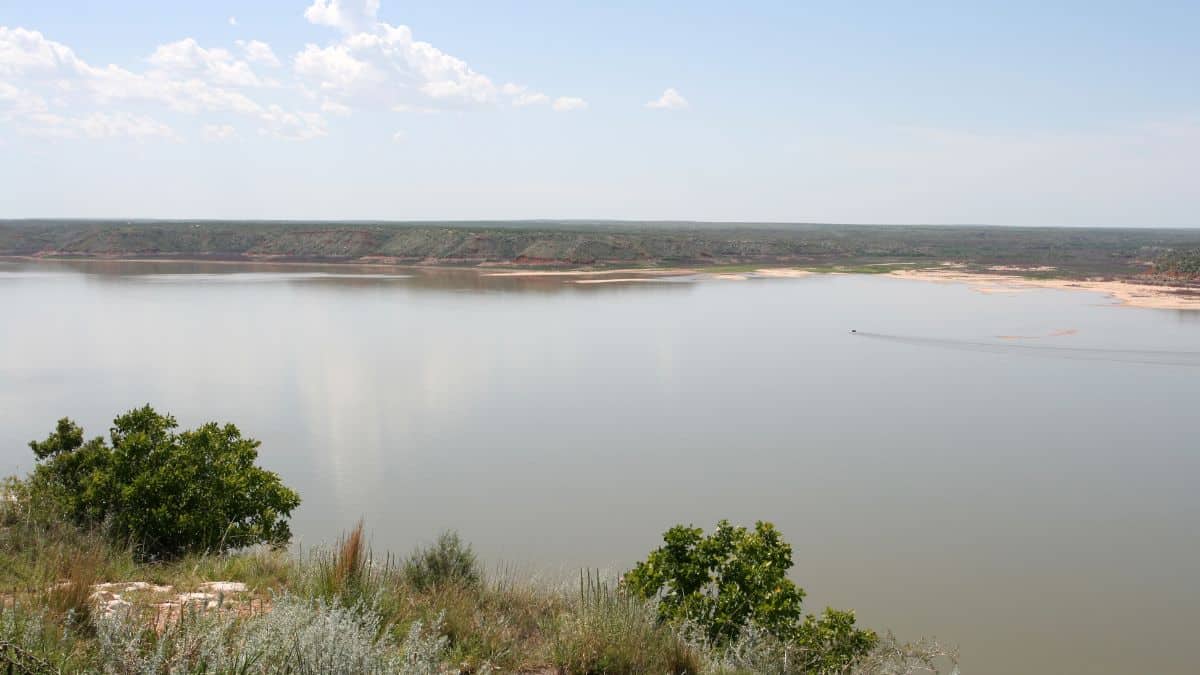
Lake Meredith, located in the Texas Panhandle, is a reservoir that provides various fishing opportunities. Its main fish species include walleye, smallmouth bass, and crappie.
The reservoir is known for its deep and clear waters, which can offer a unique challenge to anglers.
Key fishing spots at Lake Meredith include Spring Canyon, Cedar Canyon, and Harbor Bay. Spring Canyon is known for its rocky underwater structure, ideal for smallmouth bass.
Cedar Canyon offers depth ranges suitable for walleye, while Harbor Bay’s vegetated areas are perfect for crappie fishing.
| Lake Specifics | Information |
|---|---|
| Location | Texas Panhandle |
| GPS Coordinates | 35.6589° N, 101.6442° W |
| Area | 16,411 acres (surface area) |
| Max Depth | 127 feet |
| Shoreline Length | 100 miles |
| Mean Depth | 30 feet |
| Elevation | 2,941 feet above sea level |
| Volume | 505,000 acre-feet |
| Fish Species | Smallmouth bass, crappie, walleye, catfish, etc. |
| Marinas | Sanford-Yake Marina, etc. |
21. Pinkston Reservoir
Pinkston Reservoir, located in East Texas, is a small lake providing excellent bass fishing opportunities. It is particularly known for its largemouth bass population.
The lake’s size and heavy vegetation make it an ideal spot for anglers who enjoy fishing in a peaceful, natural setting.
Popular fishing spots in Pinkston Reservoir include the area around the dam and the northern coves, both provide ideal habitats for largemouth bass due to the mixture of depth ranges and underwater structures.
| Lake Specifics | Information |
|---|---|
| Location | East Texas |
| GPS Coordinates | 31.7076° N, 94.3494° W |
| Area | 523 acres (surface area) |
| Max Depth | 51 feet |
| Shoreline Length | 11.5 miles |
| Mean Depth | 19 feet |
| Elevation | 295 feet above sea level |
| Volume | 10,126 acre-feet |
| Fish Species | Largemouth bass, crappie, catfish, etc. |
| Marinas | No marinas; public boat ramps available |
22. Stillhouse Hollow Lake
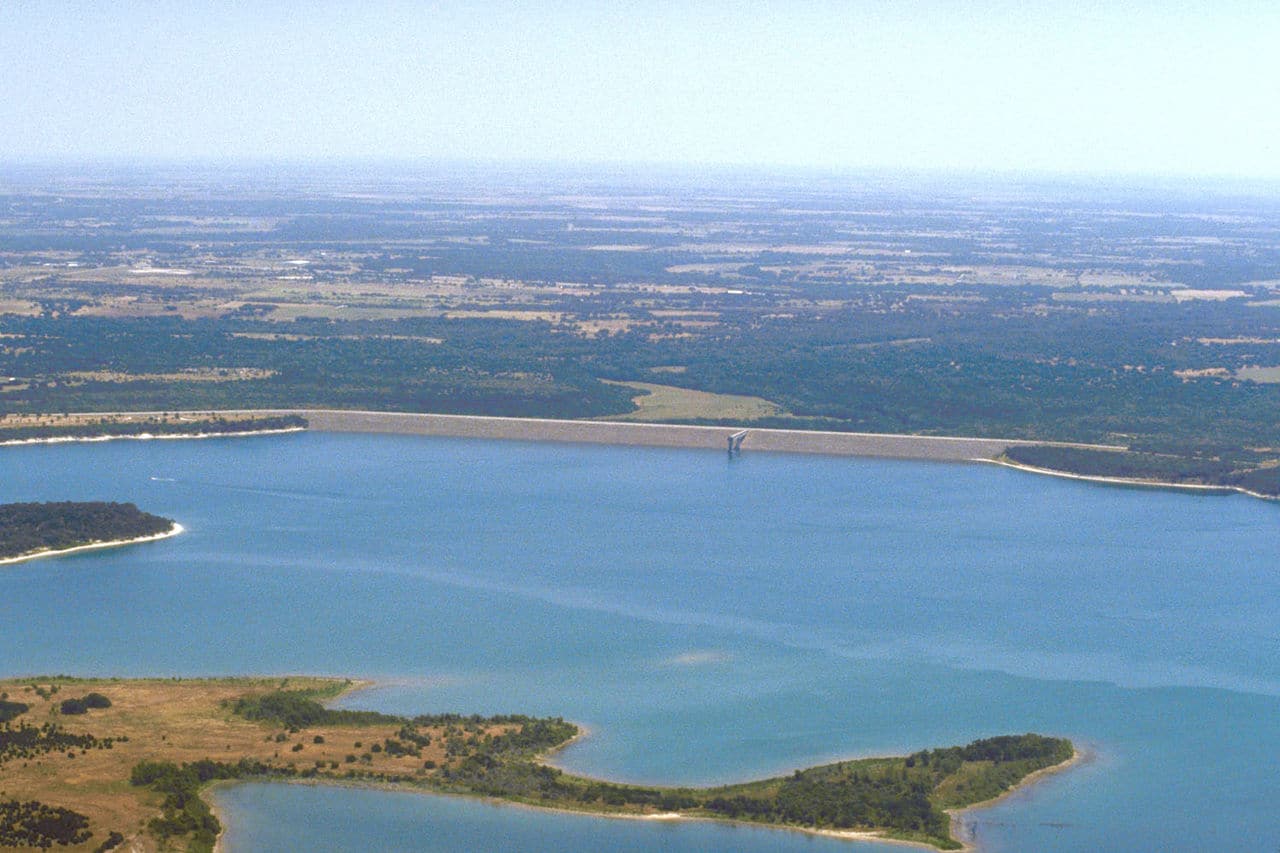
Stillhouse Hollow Lake, located in Central Texas, is a U.S. Army Corps of Engineers reservoir on the Lampasas River. This lake is known for its clear water and is popular among anglers for its largemouth bass, smallmouth bass, and crappie populations.
Key fishing spots at Stillhouse Hollow Lake include the Lampasas River arm, the dam area, and Union Grove Park.
The Lampasas River arm offers a mixture of depths and structures, making it suitable for different species. The dam area is known for its deep water, attracting largemouth and smallmouth bass, while Union Grove Park is popular for shore fishing.
| Lake Specifics | Information |
|---|---|
| Location | Central Texas |
| GPS Coordinates | 31.0233° N, 97.5735° W |
| Area | 6,430 acres (surface area) |
| Max Depth | 107 feet |
| Shoreline Length | 58 miles |
| Mean Depth | 40 feet |
| Elevation | 622 feet above sea level |
| Volume | 238,090 acre-feet |
| Fish Species | Largemouth bass, smallmouth bass, crappie, catfish, white bass, etc. |
| Marinas | Dana Peak Park, Union Grove Park, etc. |
23. Lake Lyndon B. Johnson
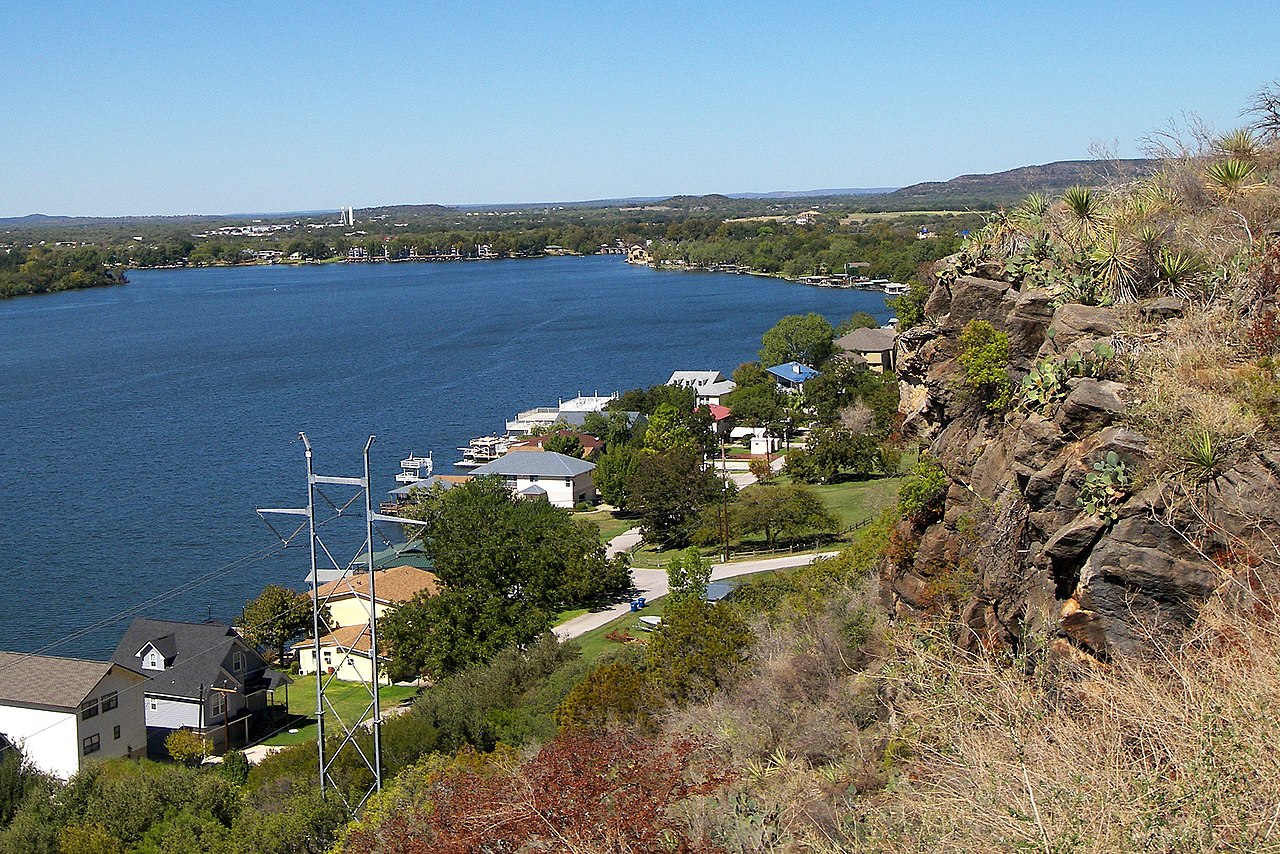
Lake Lyndon B. Johnson, commonly known as Lake LBJ, is located in Central Texas in the Texas Hill Country. It’s part of the Highland Lakes chain on the Colorado River and offers great fishing opportunities.
You will find various fish species at this lake, including largemouth bass, white bass, and crappie to name a few.
Some popular fishing spots in Lake LBJ include Granite Shoals, Kingsland Slab, and Horseshoe Bay.
Granite Shoals and Kingsland Slab are known for their rocky underwater structures, providing excellent bass habitats. With its varying depths and structures, Horseshoe Bay is another favored spot for anglers.
| Lake Specifics | Information |
|---|---|
| Location | Central Texas |
| GPS Coordinates | 30.5750° N, 98.4102° W |
| Area | 6,534 acres (surface area) |
| Max Depth | 90 feet |
| Shoreline Length | 200 miles |
| Mean Depth | 37 feet |
| Elevation | 825 feet above sea level |
| Volume | 425,400 acre-feet |
| Fish Species | Largemouth bass, white bass, crappie, catfish, etc. |
| Marinas | Bluebriar Marina, Cottonwood Creek Marina, etc. |
24. Granger Lake
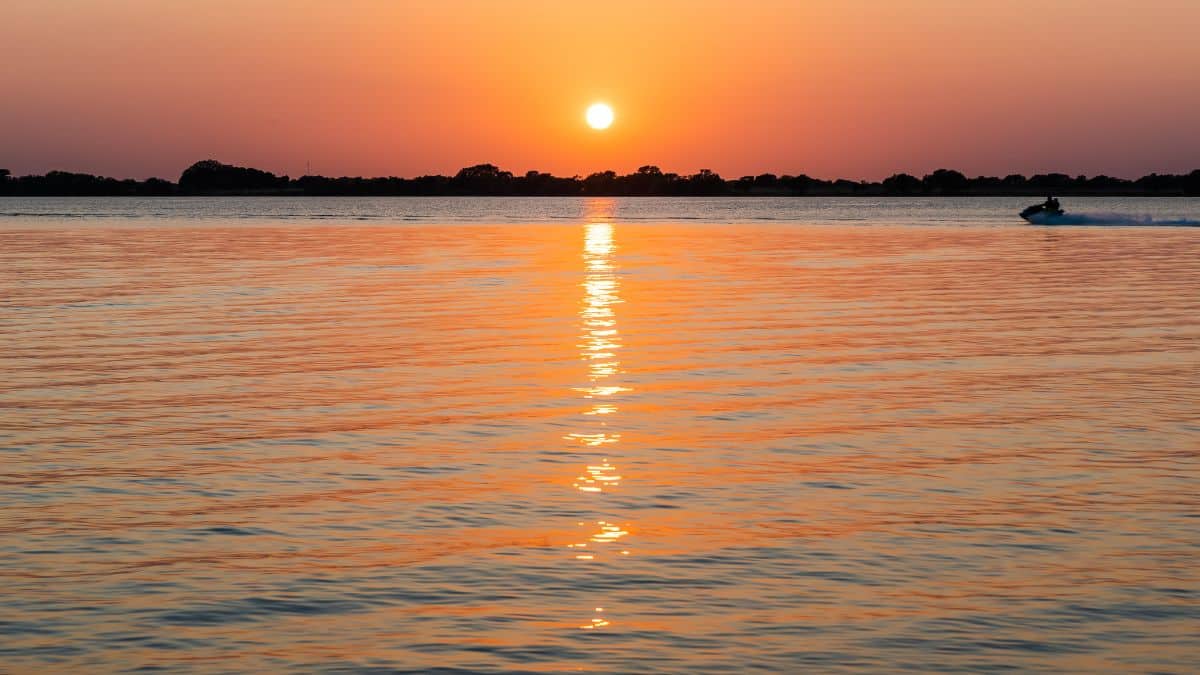
Granger Lake, located in Central Texas, is a U.S. Army Corps of Engineers reservoir on the San Gabriel River. The lake is known for its excellent white bass and crappie fishing, providing opportunities to catch catfish and largemouth bass.
Notable fishing spots at Granger Lake include the Willis Creek area, the Sore Finger area, and the San Gabriel River arm.
The Willis Creek area provides excellent spring white bass fishing, while the Sore Finger area is a popular spot for crappie. The San Gabriel River arm offers a variety of structures and depths, making it suitable for different species.
| Lake Specifics | Information |
|---|---|
| Location | Central Texas |
| GPS Coordinates | 30.7017° N, 97.3406° W |
| Area | 4,400 acres (surface area) |
| Max Depth | 50 feet |
| Shoreline Length | 61 miles |
| Mean Depth | 20 feet |
| Elevation | 504 feet above sea level |
| Volume | 59,200 acre-feet |
| Fish Species | White bass, crappie, catfish, largemouth bass, etc. |
| Marinas | No marinas; public boat ramps available |
25. Fairfield Lake
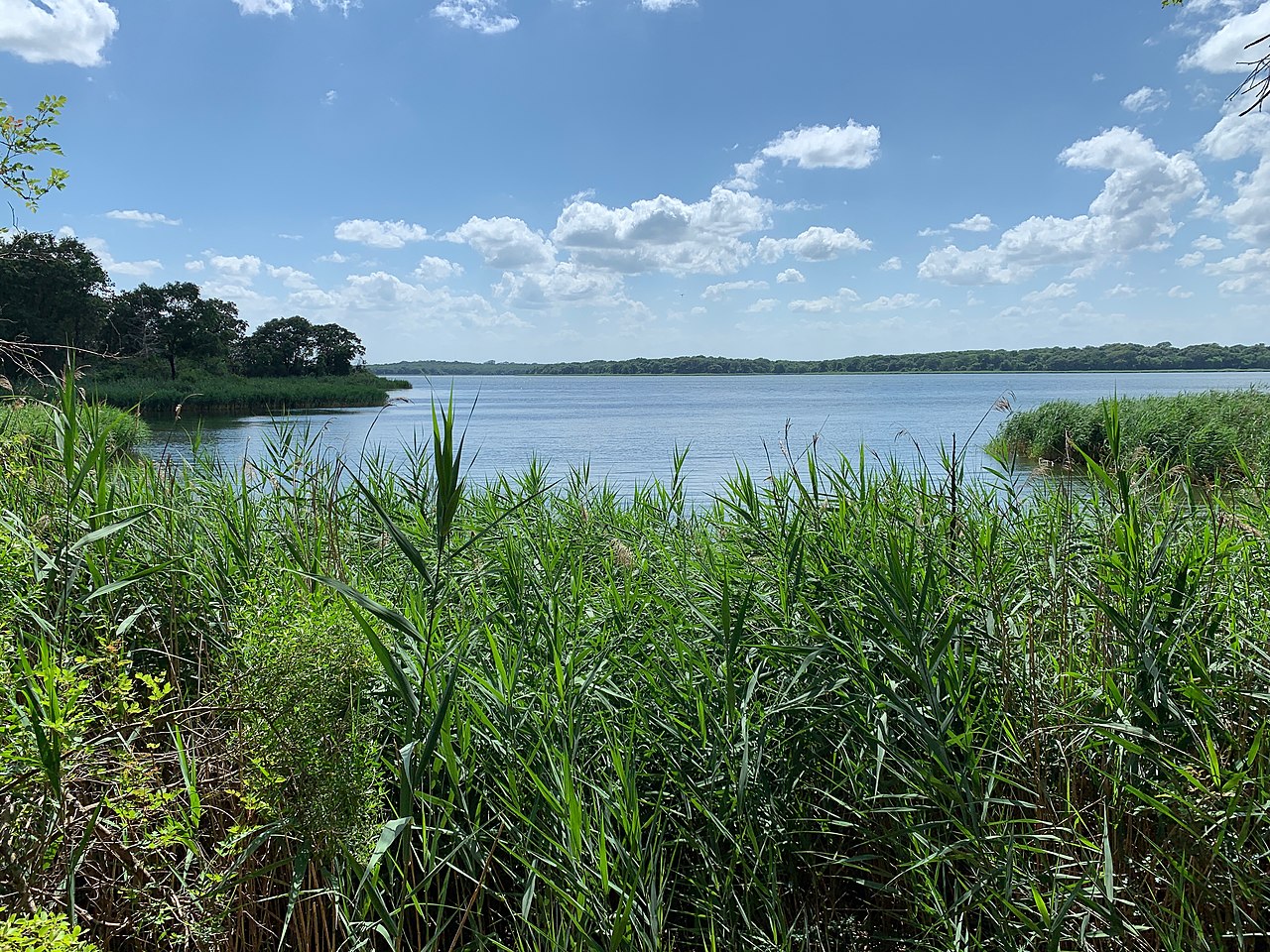
Fairfield Lake, located in East Texas, is a reservoir on Big Brown Creek, a tributary of the Trinity River. The lake offers a robust largemouth bass fishery, alongside opportunities to catch catfish and sunfish. The lake’s warm water, due to power plant operations, makes it a year-round fishing destination.
Key fishing spots at Fairfield Lake include the hot water discharge canal, the dam area, and the coves along the western shore.
The hot water discharge canal is a popular spot for winter bass fishing. The dam area offers a variety of depths, attracting largemouth bass, while the coves along the western shore provide a mixture of structures suitable for catfish and sunfish.
| Lake Specifics | Information |
|---|---|
| Location | East Texas |
| GPS Coordinates | 31.8005° N, 96.0600° W |
| Area | 2,159 acres (surface area) |
| Max Depth | 52 feet |
| Shoreline Length | 15 miles |
| Mean Depth | 19 feet |
| Elevation | 312 feet above sea level |
| Volume | 41,500 acre-feet |
| Fish Species | Largemouth bass, catfish, sunfish, etc. |
| Marinas | Fairfield Lake State Park, etc. |
Fishing Guide: 17 Best Bass Lakes in the US
Fishing for Different Species
Bass Fishing in Texas
Bass are among the most popular fish species to catch in Texas. The Lone Star State is known for its excellent largemouth bass fishing, with some of the most renowned lakes, including Lake Fork Reservoir, Sam Rayburn Reservoir, and Toledo Bend Reservoir.
Smallmouth bass and spotted bass can also be found in many Texas lakes, with Lake Texoma and Lake Amistad ideal for smallmouth bass.
It is the best time to target largemouth bass in the early spring to mid-April, while water temperatures range from 55°F to 65°F.
They are usually found in shallow waters and aquatic vegetation during this time. In contrast, smallmouth bass prefer deeper water, but they can be caught in the summer months when they’re more active.
Crappie and Sunfish
For crappie and sunfish anglers, Texas lakes offer plenty of opportunities to hook these species. White bass, for instance, is abundant in Lake Texoma and Lake Conroe, making them great lakes to visit during the spring spawn.
On the other hand, you can find a good black and white crappie population in East Texas lakes like Caddo Lake and Lake Palestine.
Sunfish, such as bluegill and redear sunfish, can be caught in various Texas lakes. San Antonio’s Choke Canyon Reservoir and West Texas’ O.H. Ivie Lake are known for their sunfish populations.
The best time to catch sunfish is during spawning, usually from late April to early June.
Catfish Fishing
Texas catfish fishing is quite an experience. The state is home to multiple catfish species, including channel, flathead, and blue catfish.
Some of the best lakes for catfish fishing are Falcon International Reservoir, Lake Amistad, and Lake Tawakoni. These lakes have many miles of shoreline, making them great places for bank fishing.
For channel catfish, enthusiasts can head down to Lake Buchanan near the Colorado River, which has a maximum depth of 132 feet. Flathead catfish are abundant in Lake Sam Rayburn and Alan Henry Reservoir, where enthusiasts can expect to catch large, trophy-sized fish.
With a bit of luck and skill, anglers can also find alligator gar and other species, such as Guadalupe bass or rainbow trout, in the southern Texas Brazos River or Rainbow Lake.
Seasonal Fishing Tips
Spring Fishing
In the early spring, especially around March, some of the best lakes in Texas to visit for great fishing include Lake Texoma, Lake Conroe, and Caddo Lake. These lakes provide excellent opportunities for catching white bass and smallmouth bass.
Fish tend to head to shallow waters as water temperatures warm up, making this an ideal time to target them. Texas Parks and Wildlife Department recommends fishing on days with moderate temperatures and overcast skies, as bass are more likely to be active.
Summer Fishing
During summer, anglers can enjoy fishing in popular spots such as Sam Rayburn Reservoir, Choke Canyon Reservoir, and Falcon Lake.
These lakes are known for their rich fish populations, including channel catfish, flathead catfish, and alligator gar.
Summer fishing often requires targeting deep water, where fish seek relief from the heat. Deeper and moving water, such as the Colorado and Brazos Rivers, can also hold fish during the hotter months.
Texas lakes in the summer can also be a great place for night fishing. San Antonio’s Calaveras Lake and Corpus Christi’s Lake Corpus Christi are good choices for those who prefer nocturnal adventures.
Fall Fishing
Fall is a perfect time to visit the state of Texas for some big fish action. As water temperatures cool down and aquatic vegetation dies off, several fish species become more active.
Anglers who venture to Lake Amistad, Alan Henry Reservoir, or Toledo Bend Reservoir will be rewarded with largemouth bass fishing opportunities and the chance to catch striped bass, black bass, and Guadalupe bass.
During this season, anglers can experiment with different fishing techniques, such as casting around submerged structures and targeting shallow and deep waters, as fish are more likely to be found at various depths.
Winter Fishing
Although winter may not be the most popular time for fishing in Texas, several lakes offer great opportunities for anglers looking to brave the colder weather.
East Texas’ Lake O’ the Pines and Lake Fork Reservoir are known for their big bass, with state records caught at Lake O’ the Pines. These lakes are known for having clear waters and abundant aquatic vegetation, providing the ideal habitat for fish during cooler months.
In southern Texas, Falcon International Reservoir and the Rio Grande River offer some of the best winter fishing opportunities, with many anglers targeting blue catfish and largemouth bass.
Fishing Guide: 25 Best Fishing Lakes in Michigan
Regional Variations
East Texas Lakes
East Texas has some of the best fishing lakes in the Lone Star State. The region offers various species, such as largemouth bass, white bass, channel catfish, and alligator gar. One of the most popular spots for anglers in this area is Caddo Lake, the only natural lake in Texas.
Its cypress trees and aquatic vegetation provide an ideal habitat for many fish species. Nearby, Lake Fork Reservoir is another favorite place, particularly for trophy-sized largemouth bass fishing. The reservoir ranks consistently among the best bass lakes in the United States.
Houston Area Lakes
Houston is one of the largest cities in Texas and is close to several great fishing lakes. Lake Conroe offers excellent fishing opportunities for largemouth bass, channel catfish, and blue catfish in its clear waters.
This lake features miles of shoreline and a maximum depth of 75 feet, making it a great place for shore and boat fishing. Choke Canyon Reservoir is another popular destination just south of Houston, particularly for anglers targeting largemouth bass and alligator gar.
Dallas-Fort Worth Lakes
In the Dallas-Fort Worth area, the best lakes for fishing include Lake Texoma and Lake Ray Hubbard. Lake Texoma, situated on the border of Texas and Oklahoma, is a massive lake with over 89,000 acres of water surface area.
This lake boasts striped bass, smallmouth bass, and catfish. It is a great lake for fishing, and its location near the Red River makes it an especially popular spot for boating enthusiasts.
Lake Ray Hubbard is another excellent choice for anglers, with species like white bass, largemouth bass, and channel catfish.
Texas Hill Country Lakes`
The Texas Hill Country region offers stunning landscapes, clear waters, and some of the best fishing lakes in the state.
For example, Lake Amistad sits along the Rio Grande River and is known for its trophy-sized, black, and striped bass. Additionally, this lake attracts anglers from all around the country because of its sheer size, encompassing nearly 65,000 acres.
Fishing enthusiasts also flock to Falcon International Reservoir, between the United States and Mexico. This reservoir ranks among the best bass lakes in the entire country and provides an optimal environment for big fish like largemouth bass and catfish.
Its maximum depth is 110 feet, with deeper water temperatures remaining fairly stable throughout the year.
Finally, in the heart of the Texas Hill Country lies Lake Travis, a popular destination for fishing and recreational activities. This lake is part of the Colorado River chain and allows anglers to catch largemouth bass, Guadalupe bass, and white bass.
Facilities and Amenities
Boating and Launch Ramps
Many of the best fishing lakes in Texas offer excellent boating facilities. At Lake Texoma, boaters will find multiple well-maintained boat ramps to launch their vessels.
Lake Conroe and Choke Canyon Reservoir also have top-notch boat ramps, making it easy for anglers to access deeper water and prime fishing spots.
Similarly, Falcon Lake, Sam Rayburn Reservoir, and Lake Amistad provide boating facilities catering to novice and experienced anglers.
- Lake Texoma: Offers numerous boat ramps suitable for both small and large boats
- Lake Conroe: Features multiple well-maintained boat ramps and docks
- Choke Canyon Reservoir: Easy access to boat ramps and miles of shoreline
Camping and Accommodations
Anglers visiting fishing hotspots in Texas can enjoy a variety of camping and accommodation options. At the Sam Rayburn Reservoir, visitors can choose from several campgrounds managed by Texas Parks and Wildlife or the United States Forest Service.
Meanwhile, Lake Amistad offers camping facilities for both RVs and tents, with fishing piers and picnic areas available.
In East Texas, Caddo Lake boasts lush cypress trees and timber-covered shorelines, providing a unique natural camping experience.
Other popular lakes, such as Lake Conroe and Toledo Bend Reservoir, are nearby major cities like San Antonio and offer many options for accommodations, including hotels and bed and breakfasts.
| Lake | Camping Options | Nearby Accommodations |
|---|---|---|
| Sam Rayburn | Texas Parks and Wildlife, Forest Service campgrounds | Hotels, lodges |
| Lake Amistad | Camping facilities for RVs and tents, fishing piers and picnic areas | Bed and breakfasts, hotels |
| Caddo Lake | Picturesque natural camping among cypress trees and timber | Various accommodations |
| Lake Conroe | Well-equipped campgrounds | B&Bs, hotels close to San Antonio |
| Toledo Bend Reservoir | Camping options for RVs and tents, with easy access to fishing piers and picnic areas | Lodges, hotels nearby |
Fishing Guide: 25 Best Fly Fishing Rivers in the USA
Natural Features and Habitat
Texas is home to many fishing lakes offering diverse natural features and habitats suitable for various fish species. In this section, we will explore the vegetation and cover, as well as structures and depths of these best fishing lakes in Texas.
Vegetation and Cover
Aquatic vegetation plays a vital role in the overall health of a lake’s ecosystem. In many Texas lakes, such as Caddo Lake, Cedar Creek Lake, and Lake Conroe, various aquatic vegetation can be found, including hydrilla and submerged timber.
These plants offer ideal largemouth bass, smallmouth bass, and channel catfish habitat.
- Hydrilla: This submerged aquatic plant provides excellent cover for fish, especially in lakes such as Lake Sam Rayburn and Lake Amistad. It can be found in various water depths, making it a versatile habitat for different species.
- Submerged Timber: Submerged timber can be found in numerous lakes in East Texas, including Sam Rayburn Reservoir and Toledo Bend Reservoir. This structure creates a natural cover for fish such as crappie and white bass.
Structures and Depths
The structures and depths of Texas lakes can greatly contribute to the diversity of fish populations. From natural lakes to impoundments, these bodies of water offer a range of habitats for anglers to target.
- Natural Lakes: Caddo Lake, the only natural lake in Texas, exhibits unique shallow waters, with depths reaching around 20 feet. Populations of species such as alligator gar and blue catfish thrive in this environment.
- Impoundments: Impoundments, or man-made reservoirs, can be found throughout Texas. These include Lake Texoma, Falcon International Reservoir, and Choke Canyon Reservoir. These large lakes often have varying depths and structures, offering habitat for big fish like striped bass and flathead catfish.
- Maximum Depth: Some impoundments boast significant depths, with the deepest point at Toledo Bend Reservoir reaching 110 feet. Deep water can be an ideal habitat for species such as striped bass and smallmouth bass during summer months and water temperatures increase.
- Miles of Shoreline: Impoundments like Lake Conroe and Falcon Lake offer extensive shoreline access, providing plenty of opportunities for anglers to target fish from the shore or by boat.
Fishing Techniques and Tackle
When fishing in Texas, anglers should know various techniques and tackle choices to maximize their success. This section will cover preferred lure selection, the methods of trolling and drift fishing, and advice for bank fishing and shore fishing in the Lone Star State’s best lakes.
Lure Selection
Year-round fishing in Texas means being prepared with a versatile set of lures. When targeting white bass, for example, in Lake Texoma or Caddo Lake, it’s vital to stock up on crankbaits.
These lures are effective in deeper water, perfect for areas like bridge crossings and creek channels with a maximum depth.
Rip-rap shorelines and creek arms also hold promising opportunities for anglers seeking smallmouth bass in lakes such as Lake Conroe and Sam Rayburn Reservoir.
Trolling and Drift Fishing
Trolling is an excellent fishing technique in vast reservoirs like Falcon Lake and Choke Canyon Reservoir, where striped bass and largemouth bass reside.
Trolling at various water depths increases your chances of hooking a big fish, as water temperatures and aquatic vegetation distribution vary throughout these lakes.
Drift fishing is another popular method in the state of Texas. It allows anglers to cover large areas, like the expansive shorelines of Toledo Bend Reservoir and San Antonio’s Canyon Lake, without exerting too much energy.
This approach is particularly effective for targeting white bass and channel catfish in deeper water close to submerged structures.
Bank Fishing and Shore Fishing
Bank fishing and shore fishing in Texas can yield impressive results, with options like the renowned Lake Fork Reservoir and Lake Amistad offering miles of shoreline.
East Texas’ Caddo Lake, known for its cypress trees and abundant aquatic vegetation, is an ideal habitat for alligator gar, blue catfish, and flathead catfish. Bob Sandlin Lake offers a fishing pier for anglers hoping to land big bass without needing a boat.
For those near the Colorado River, bank fishing is a popular spot for catching Guadalupe bass and black bass. Lake Alan Henry Reservoir offers excellent shoreline access and numerous boat ramps, making it a favorite place among locals and visitors to cast a line.
Remember, a Texas fishing license is required to fish in these lakes, and respecting local regulations is essential to preserving this unique natural resource.
By using the appropriate fishing techniques and tackle, anglers of all skill levels can enjoy a successful day on the water in the beautiful lakes of the Lone Star State.
Fishing Guide: 21 Best Bass Fishing Lakes in Florida
Fishing Tournaments and Conservation
Fishing Tournaments in Texas
Texas is well-known for its abundance of fishing opportunities, and fishing tournaments are a popular way for anglers to showcase their skills.
Some of the best lakes for tournament fishing in the Lone Star State include Lake Texoma, Lake Conroe, Choke Canyon Reservoir, Falcon Lake, Sam Rayburn Reservoir, and Lake Amistad.
Lake Texoma, situated on the Texas/Louisiana border, boasts rich white and smallmouth bass populations.
The lake covers over 89,000 acres and is a favorite spot for various tournaments, such as the Big Bass Splash and the American Bass Anglers Roundup. Another great place to fish is Eisenhower State Park on the Texas side, offering an accessible fishing pier and boat ramps.
The Guadalupe River in the Texas Hill Country is another well-known spot for tournaments, particularly for its Guadalupe bass population. With breathtaking scenery, the River offers an awe-inspiring backdrop for the annual Texas Fly Fishing & Brew Festival.
Lake Management and Conservation
The management of these vast water bodies often involves the collaboration of multiple agencies, such as the U.S. Army Corps of Engineers and Texas Parks and Wildlife Department. They implement various strategies to ensure the health and longevity of the fisheries.
For example, at Lake Conroe, the San Antonio Water System collaborated with Texas Parks on a project to introduce native aquatic vegetation to improve water quality and provide ideal habitat for various fish species.
This effort significantly enhanced the lake’s ecosystem, and anglers can now find a variety of fish to target, including largemouth bass, channel catfish, and flathead catfish.
Lake management extends to conservation efforts, such as those at Caddo Lake. Located in East Texas, this natural lake features cypress trees, shallow waters, and a diverse array of fish species.
In recent years, the implementation of a strict catch-and-release regulation for largemouth bass has improved the lake’s fish population. This site offers anglers unique opportunities to catch alligator gar, blue catfish, and striped bass during their fishing trips.
Conservation practices on Falcon International Reservoir
This large lake on the Rio Grande River sees collaborative efforts between the United States and Mexico to maintain water levels and stabilize fish populations.
Anglers at Falcon Lake can expect excellent fishing opportunities, with largemouth bass being the main attraction.
Conclusion – Best Fishing Lakes in Texas
Texas offers a wide range of fishing lakes with impressive tournament opportunities. The involvement of governmental and local agencies in lake management and conservation ensures that these lakes will remain popular destinations for anglers in the future.
Keep in mind that a valid Texas fishing license is required to fish in the state, and always adhere to local regulations and guidelines to help protect the resources for generations to come.
If you have had success fishing at any of these lakes in Texas we would love to hear from you. Please leave a comment below. Until next time Happy Fishing!
Frequently Asked Questions (FAQ)
What are some of the best fishing lakes in Texas?
Texas offers numerous excellent fishing lakes, including Lake Fork, Lake Texoma, Sam Rayburn Reservoir, Toledo Bend Reservoir, and Falcon Lake.
Which fish species are found in Lake Fork?
Lake Fork is renowned for its largemouth bass fishing. Apart from bass, it’s also home to crappie, catfish, and sunfish species.
When is Lake Texoma most productive for fishing?
While Lake Texoma provides year-round fishing, striped bass, also known as striper, fishing is particularly productive in the spring and fall.
Do I need a fishing license to fish in Texas lakes?
Most individuals fishing in Texas lakes are required to have a fishing license. There are, however, exceptions, such as children under 17 and individuals fishing within a State Park.
How can I acquire a fishing license in Texas?
Fishing licenses in Texas can be procured online through the Texas Parks & Wildlife Department’s website, at a licensed retailer, or via phone.
Can I fish at night in Sam Rayburn Reservoir?
Night fishing is permitted at Sam Rayburn Reservoir.
What facilities are available at Toledo Bend Reservoir?
Toledo Bend Reservoir offers a range of facilities, including boat ramps, campgrounds, picnic areas, and bait and tackle shops.
Which is better in Falcon Lake – boat fishing or shore fishing?
Both boat and shore fishing can be fruitful at Falcon Lake. The choice between the two depends on personal preference, the lake area you’re fishing in, and the fish species you’re targeting.
Are there specific size and bag limits for fish in Texas lakes?
Yes, Texas enforces size and bag limits for many fish species to ensure sustainable fishing practices. These regulations vary by lake and species, so verifying the current rules before fishing is essential.
What’s the largest largemouth bass ever caught in Texas?
The state record for largemouth bass in Texas is 18.18 pounds, caught in Lake Fork.

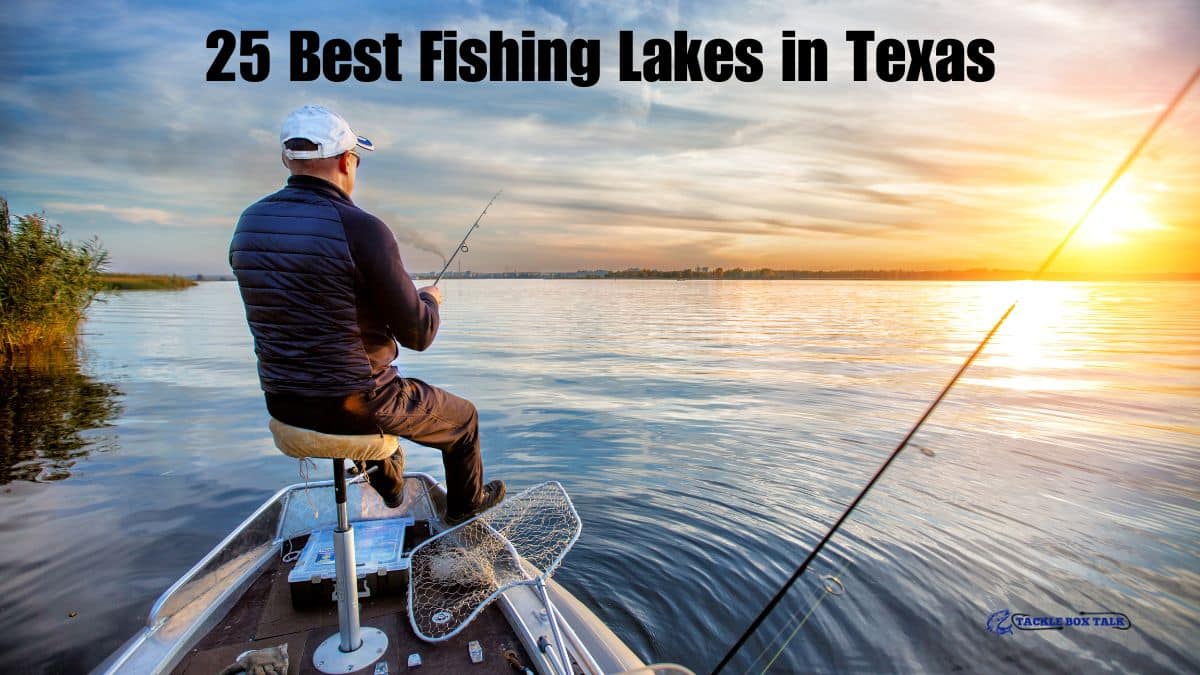
Cory Haasnoot
Cory is a content writer-editor and founder of Tackle Box Talk. Favorite Quote: "Give a man a fish, and you feed him for a day. Teach a man to fish, and you feed him for a lifetime."